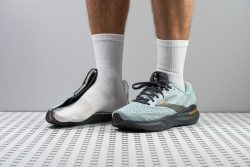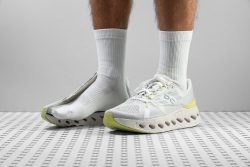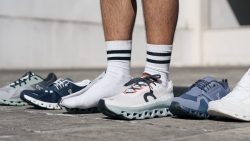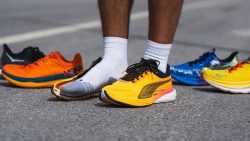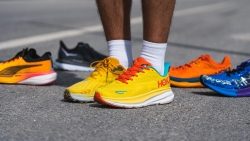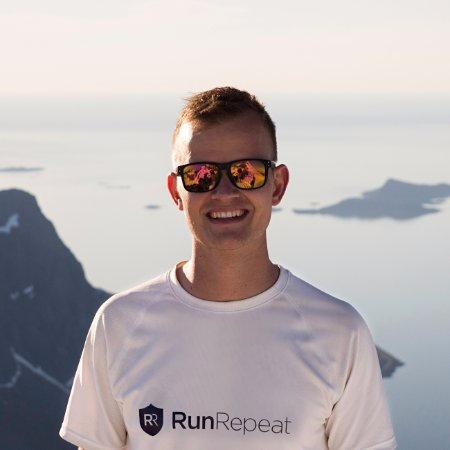7 Best Running Shoes For Achilles Tendonitis in 2025
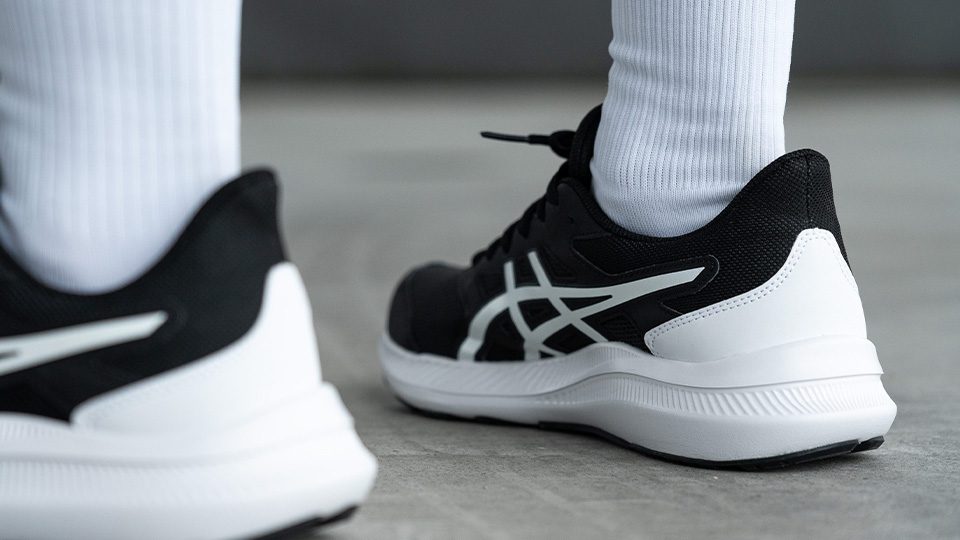
We buy shoes ourselves. We earn commissions when you buy through us, at no extra cost. Why trust us
The burning sensation in the Achilles tendons is annoying, especially when it comes and goes or happens when you're supposed to be at your training peak. There are a few running shoe features that may help in this case, next to resting or taking things slower (moving to daily trainers for sure). We discuss these features here, and we highlight the best running shoes for painful Achilles tendons.
How we test running shoes for Achilles tendonitis
To make our shoe reviews as objective as possible, we make sure to: buy all the running shoes on our own, test them on our test runs in various weather conditions and surfaces, and test them in our lab.
We standardized our lab tests, so each shoe is treated the same. When doing durability tests, we always apply the same pressure, RPMs, and time duration; when freezing the shoes to measure how their softness changes in cold weather, we keep all the shoes in the freezer for the same amount of time. We always use the same tools and publish our reviews on the website, along with all the lab data we gather.
Best running shoe for Achilles tendonitis overall
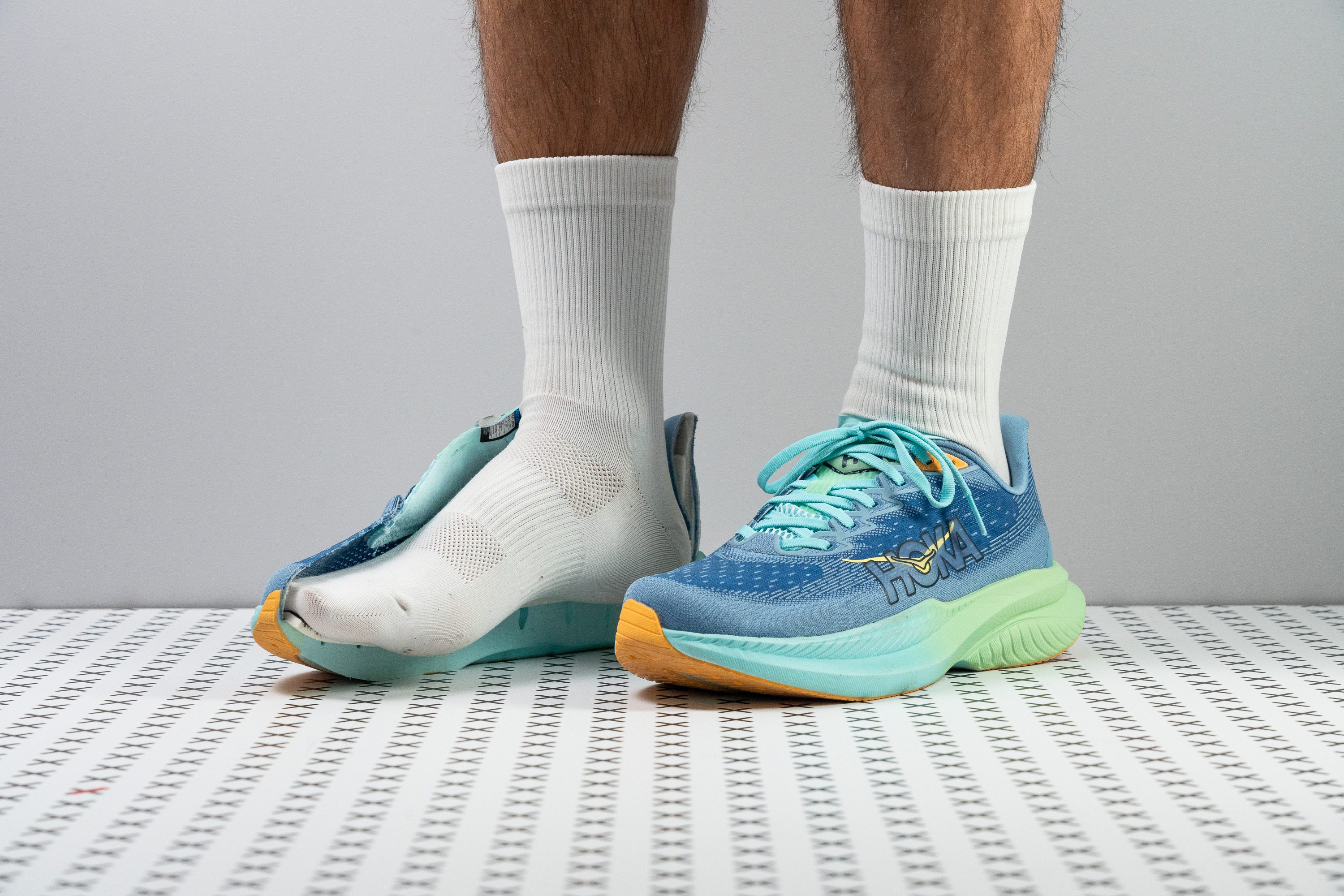





















































What makes it the best?
This shoe delivers on all fronts when it comes to painful Achilles tendons, which is why it's our #1 pick here. It offers a perfect balance of support, stiffness, and comfort that is much needed when experiencing Achilles tendinopathy.
Most runners who are dealing with Achilles tendonitis enjoy cushioned running shoes, specifically the heel. Focus is on the heel and not the forefoot because landing on the forefoot asks for more work from those tendons, so running slower can help, and walking as well (instead of running). Fortunately, Mach 6 features 36mm of lively foam at the heel and this high-stacked foam is surprisingly super stable!
In the lab, we don't like seeing big variations between what the brands advertise and what we measure, but in the case of Mach 6, this is a welcome change when we put it in the Achilles tendinopathy scenario. The drop is not 5 mm but 9.6 mm! This is exactly what we recommend (heel-to-toe drop higher than 9 mm) for Achilles pain.
To perfectly hug the heel, there's a heel counter that scored 4/5 on our stiffness test. It's not just stiff but also nicely padded. This heel cup does not irritate the heels but locks them securely.
Hoka Mach 6, unfortunately, has a tapered toebox. This works well for some runners, but those who need more room in the toebox around the toebox (who need less pointy toeboxes) should look elsewhere.
Pros
- Really lightweight
- Fantastic outsole
- Exciting ride
- Highly cushioned
- Great for heel strikers
- Handles faster paces
- Superb lockdown
- Excellent value at $140
Cons
- Drop varies from stated
- Tapered toebox
- Thin tongue
Running shoes for Achilles tendonitis with the best shock absorption
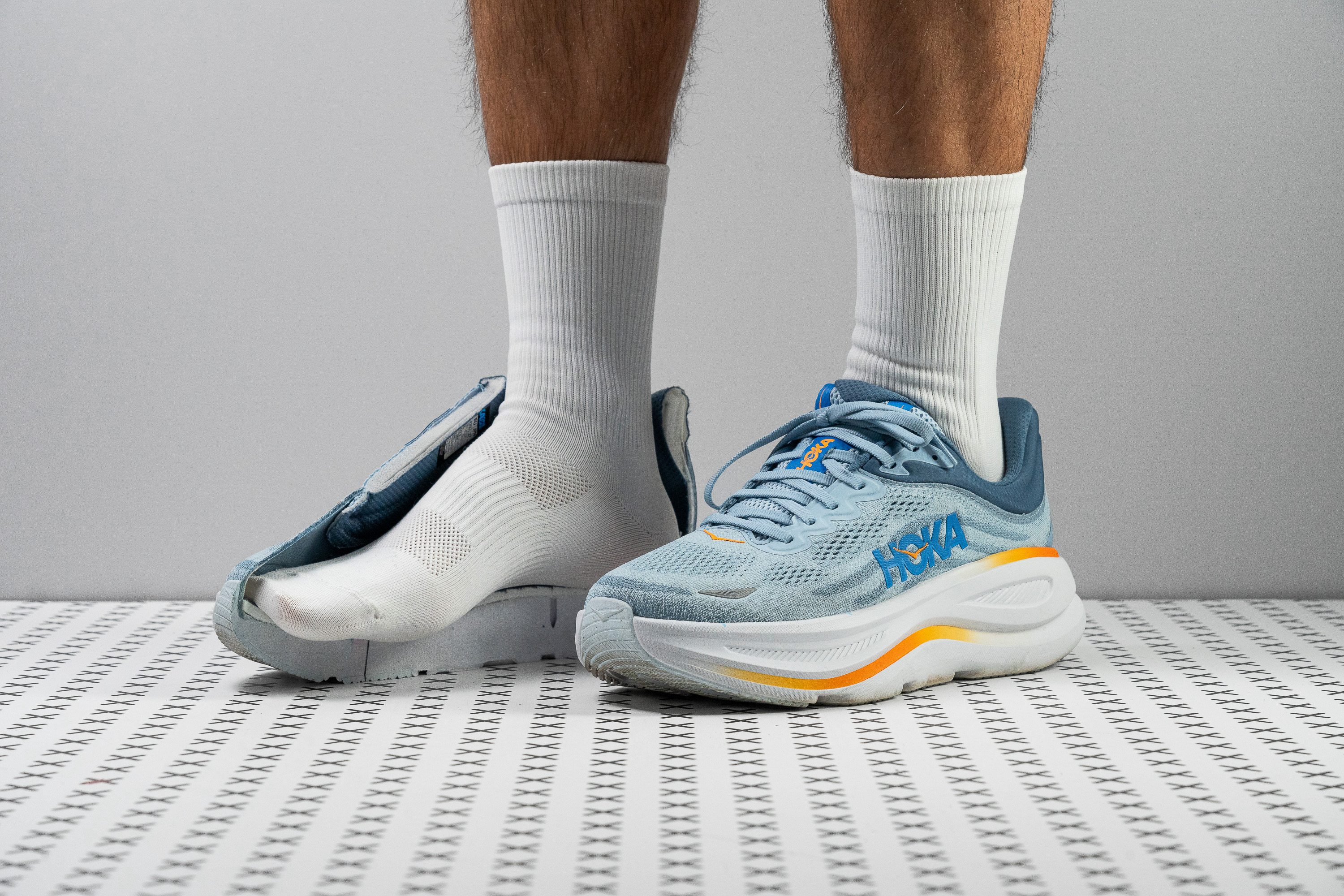

















































What makes it the best?
The Hoka Bondi 9 is an oversized trainer that took the load off our feet and put the fun in our runs. Lab results show it features a heavily cushioned yet responsive midsole, with broad measurements to enhance support. In our runs, we immediately felt the comfort it offers, making it our best shock absorption for runners dealing with Achilles Tendonitis.
Our caliper reveals a massive 41.3/32.2 mm stack beneath our feet, verifying the bottomless comfort we enjoyed. The foam’s plush nature made each touchdown kind to our legs, proven by high shock absorption scores of 146 SA in the heel and 133 SA in the forefoot. Its performance suggests all foot strikers will enjoy less muscle stress.
What makes the ride so much more impressive is its ability to return the force we put in the midsole. In our energy return test, the heel returned 60.2% while the forefoot returned 60.3%, showing that we don’t have to think about having a dull ride in this trainer.
Bondi 9 features an exceptionally broad platform, making our jaws drop with its 123.2/100.9 mm base. Built with elevated sidewalls, it supports our footing and keeps us planted inside the shoe. This minimizes the chances of losing balance and triggering muscle or joint pain.
However, its toebox is surprisingly narrow compared to its oversized platform. Those who want more room for wide feet or comfortable toe splay should try another pair.
Pros
- Endless cushioning
- New supercritical EVA midsole
- Amazing step-in comfort
- Doubles as a walking shoe
- Stable for its height
- Built to last
- Excels at slow-and-steady paces
- Well-designed heel collar
- Lighter than v8
Cons
- Not for wide feet
- Still feels heavy and clunky underfoot
- Drop measurement differs from stated
- Non-gusseted tongue
Best stability running shoes for Achilles tendonitis
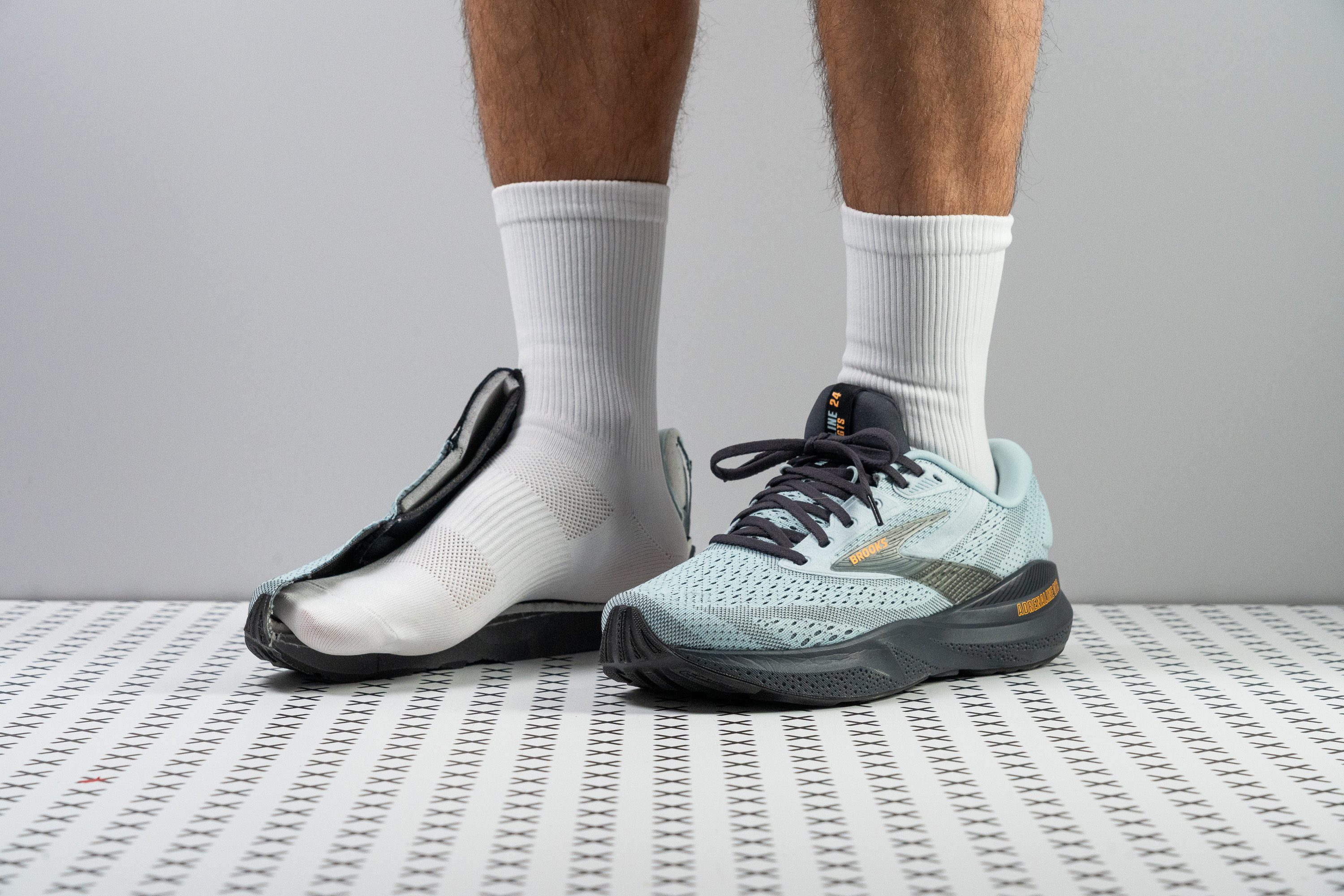
















































What makes it the best?
Runners dealing with Achilles Tendonitis need both comfort and support, and that’s exactly what the Brooks Adrenaline GTS 24 delivered in our runs. It’s well-cushioned and flexible, which prevents muscle strain. Meanwhile, our lab work shows the GuideRails system is this shoe’s core support, making it our best stability pick in the Achilles Tendonitis category.
The GuideRails extend along both sides of the midsole, raising the sidewalls and creating a more centered ride. It avoids excessive lateral movement, proven by its high 4/5 torsional rigidity rating. The shoe also features a medial post that limits excessive arch collapse.
Thankfully, the midsole is agreeable for foot-bending movements. In our 30-degree test, Adrenaline GTS 24 emerged 32.7% more pliable than average, making it suitable for daily training.
Beneath our feet lies a generously cushioned midsole, with an impressive stack height of 39.0/25.5 mm. The resulting drop is steep at 13.5 mm, putting us in a raised position that makes our higher leg muscles do more work. In effect, we avoid overworking our ankles and Achilles.
However, the toebox sits quite low with only a 25.4 mm vertical clearance. Those with high-volume feet or pointy toes may find this a bother.
Pros
- Stack height upgrade!
- Reliable support
- Breathable mesh with oversized vents
- Price remains unchanged
- Available in 4 width options
- Good durability
- Plush tongue for top comfort
- Ideal for heel strikers
- Foam upgrade to DNA Loft v3
Cons
- Firmer-than-expected midsole
- High drop may feel too steep
- Toebox height is a bit low
- Non-gusseted tongue
Running shoes for Achilles tendonitis with the best durability














































What makes it the best?
Smashing our Dremel tests on all fronts in the lab, the ASICS Gel Kayano 32 takes the crown for durability among Achilles Tendonitis running shoes. Complementing its hard-wearing nature is a plush and shock-absorbing midsole. No shortage of cushioning and protection here; it takes good care of our muscles and avoids triggering any pain.
The GK32 not only passed our Dremel tests, but did so with flying colors in the outsole, toebox, and heel. It performed better than average with its minimal 0.7 mm dent in the outsole. Meanwhile, it scored above-average ratings of 4/5 in the toebox and heel padding, ensuring that this shoe will last long.
We measured the towering stack at 39.9/30.6 mm, verifying it’s ready for long, slow distances. It features a steep 9.3 mm drop, which effectively reduces pressure on our Achilles since it encourages rear striking.
In addition to its height, the foam itself is a joy on foot. Each landing feels kind to our muscles and joints, proven by high shock absorption scores of 133 SA (heel) and 116 SA (forefoot).
Because of its impressive wear resistance, we wish the outsole were thinner to make the shoe feel lighter. At 4.5 mm, we find it too thick and bottom-heavy compared to the 3.2 mm average.
Pros
- Amazing shock absorption
- Plush and breathable upper
- Made to last
- Dependable for most pronators
- Heavy-duty outsole with excellent grip
- Stable as a table
- Pillow-soft heel padding
- Improved fit
- Excellent build quality
Cons
- Not for soft-foam lovers
- Bad energy return
- Overpriced in Europe
Best lightweight running shoes for Achilles tendonitis
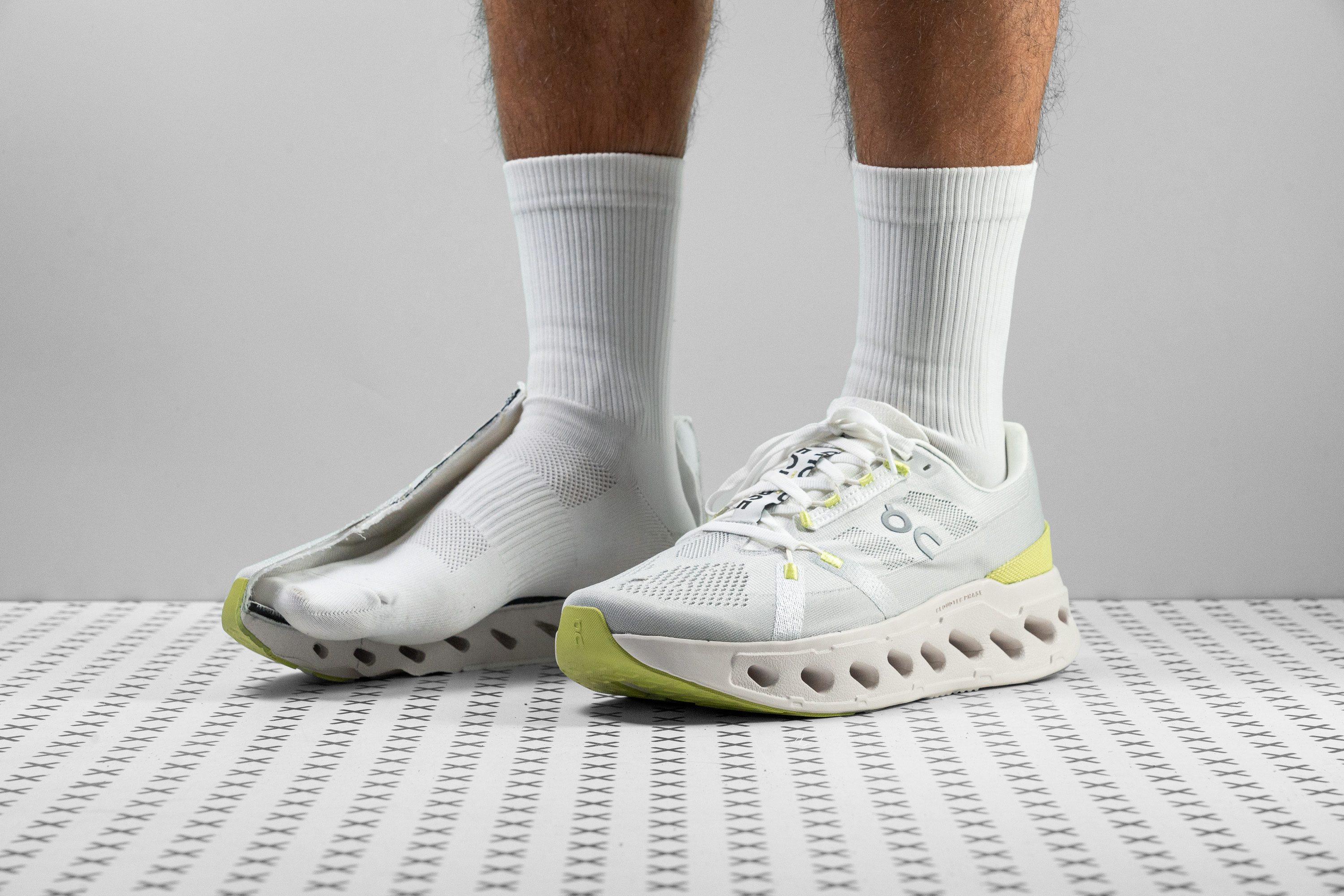
















































What makes it the best?
The On Cloudeclipse delivers a soothing sensation in our runs with its abundant and impact-protective cushioning in a minimal package. Meanwhile, it has structure in the right areas, enhancing stability and creating a safer environment for our feet. Proven by our lab work, the Cloudeclipse is the best lightweight shoe for runners dealing with Achilles Tendonitis.
When we want to pick up the pace, we don’t have a hard time doing so since the shoe feels easy on the feet. At 9.6 oz (272g), it’s impressively light for its size!
Cloudeclipse is a true maximalist, with a thick 39.9/30.5 mm stack beneath our feet. Testing for its shock-absorbing capabilities, the heel returned a strong 141 SA and the forefoot a solid 124 SA, verifying the well-cushioned sensations we had. At this level, the landing force is reduced and therefore puts less strain on our bodies.
Measuring the resulting heel drop, our caliper returned a steep 9.4 mm, which encourages rear striking and lessens the load on our Achilles. To ensure stable strides, the midsole offers stiffness to keep us centered. In our manual twist test, we rated it with a solid 4/5. This result helps avoid overworking our muscles and mitigates excessive lateral movement.
However, its $180 price tag may burn a hole in the pocket. Runners on a budget may explore cheaper alternatives in the market.
Pros
- Most cushioned On model to date
- New CloudTec Phase technology enhances speed
- Improved upper with better durability and breathability
- Extremely long-lasting outsole and upper
- Effective heel lock
- Good stability considering its stack height
- Comfortably smooth ride
- Excellent lockdown for regular-width feet
Cons
- Helion foam lacks energy return
- Seems overpriced, like other On models
- Actual drop significantly varies from the stated measurement
Best tempo running shoes for Achilles tendonitis
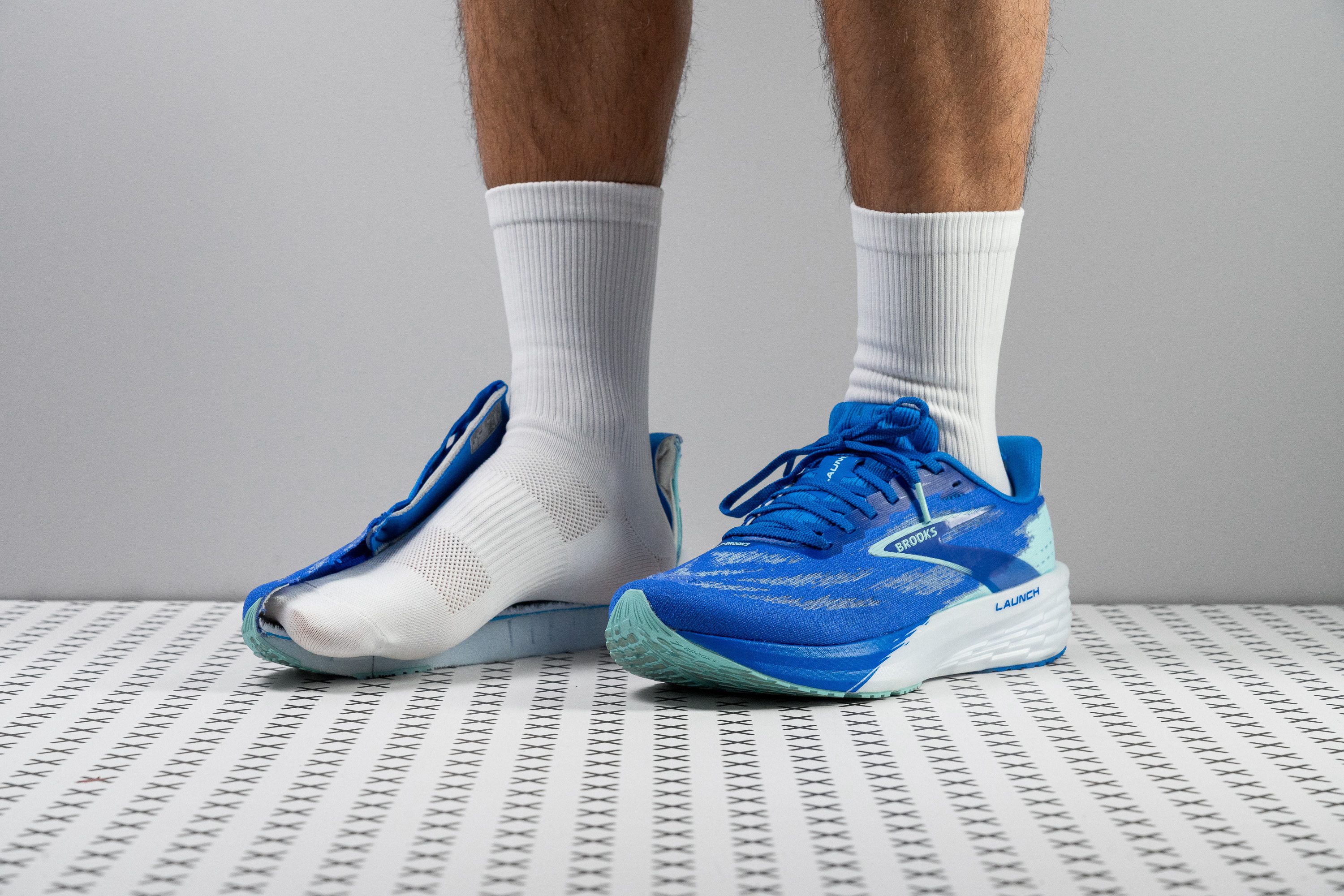

















































What makes it the best?
Giving justice to its name, the Brooks Launch 11 propelled us seamlessly in our runs, offering speed through its lightweight package, comfort through its protective cushioning, and protection through its subtle stability elements. Among Achilles Tendonitis running shoes we tested on foot and in the lab, it stood out as our top tempo trainer.
Launch 11 flows with our feet, and our scales verify it’s far from being a burden with its minimal 8.4 oz (237g) build. Being 10.6% lighter than average, it’s easy to pick up the pace when we want to.
Despite its moderate stack height, Launch 11 never felt harsh during landings. We credit the midsole’s impressive shock absorption, especially in the heel, scoring 129 SA. The shoe also features a steep 9.5 mm offset, which reduces the load on our lower leg muscles, like the ankles and Achilles.
To avoid putting more strain on our feet, Launch 11 has a firm foothold and a centered ride. The stiff heel (4/5) adds ankle support, while the torsion-resistant (4/5) midsole contains excess lateral movement. With a 5/5 rating offering the highest rigidity and support, these scores felt subtle yet highly effective.
The toebox features a tight, race-ready fit that may not suit many runners. We recommend that those with pointy toes or high-volume feet consider a more accommodating shoe.
Pros
- Revamped nitrogen-injected midsole
- Great upper breathability
- Still fairly priced
- Snug and secure fit
- Improved for heel strikers
- Agile and nimble ride
- Works for daily miles and speed workouts
- Improved stability
Cons
- Price increase from v10
- Low-volume toebox
- Firm ride
- Minor weight gain
Best budget running shoes for Achilles tendonitis
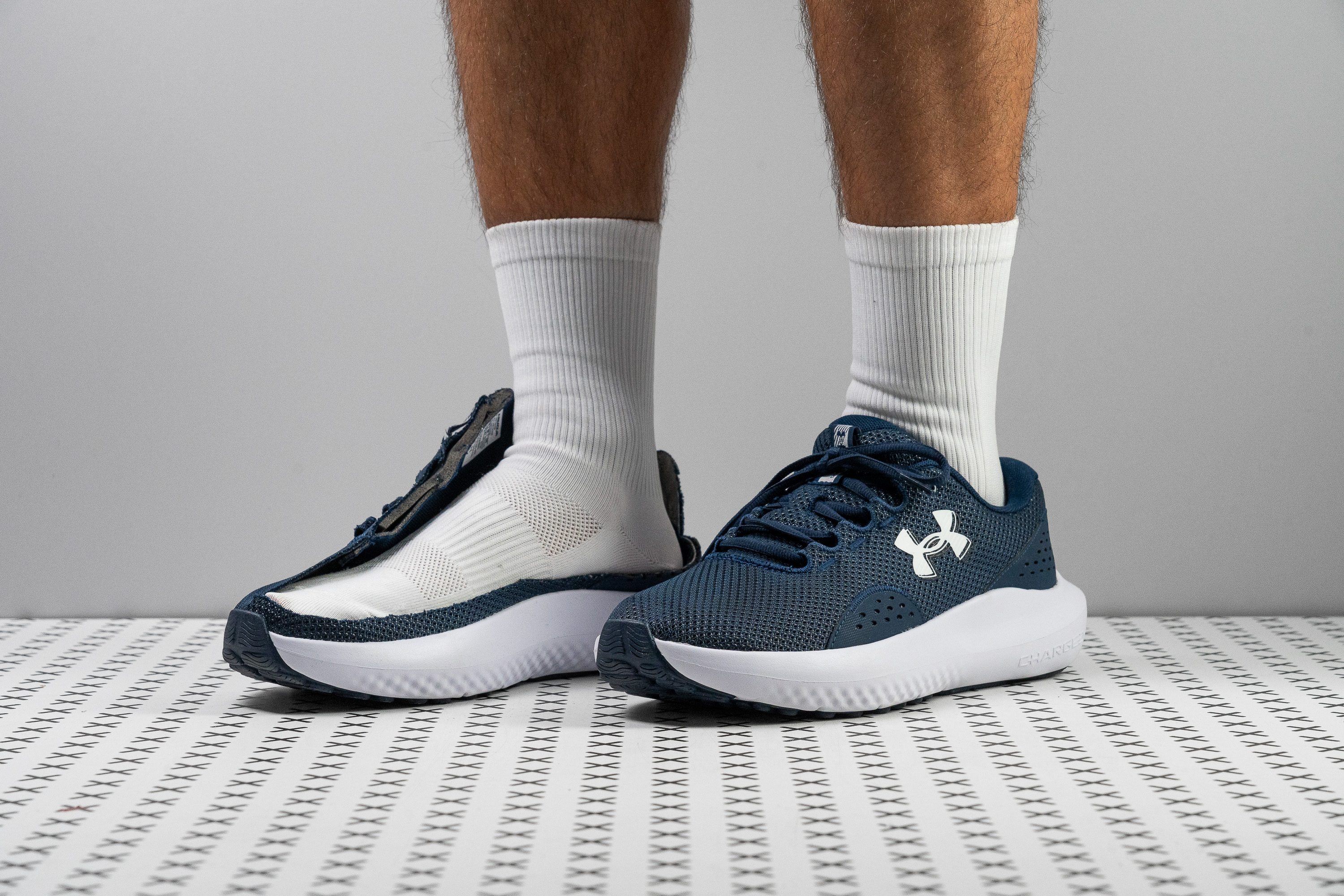











































What makes it the best?
Pros
- Good traction
- Very affordable price
- Stable and secure ride
- Ideal for heel strikers
- Comfortable heel and tongue
- Suitable for daily wear
- Pressure-free lacing system
- Durable outsole
Cons
- Very low energy return
- Weak shock absorption
- Not for serious running
- Firm feel underfoot
This guide serves its educational purpose and is in no way here to give medical advice. If you’re experiencing discomfort or pain, consult a specialist.
|
Here we cover the features of shoes that might help runners experiencing pain in the Achilles tendons. However, we must highlight that dealing with Achilles tendonitis is all about rehab, not shoes. That is why it is important to get properly diagnosed and treated. |
Painful Achilles tendons
Pain in the Achilles tendon is also known as Achilles tendinopathy or Achilles tendinosis (shortened AT). This tendon, which connects a calf to the heel bone, starts hurting because it is being overused. If a runner insists on running with the Achilles tendinopathy, this can lead to the tendon rupture, which may need to be fixed with surgery.
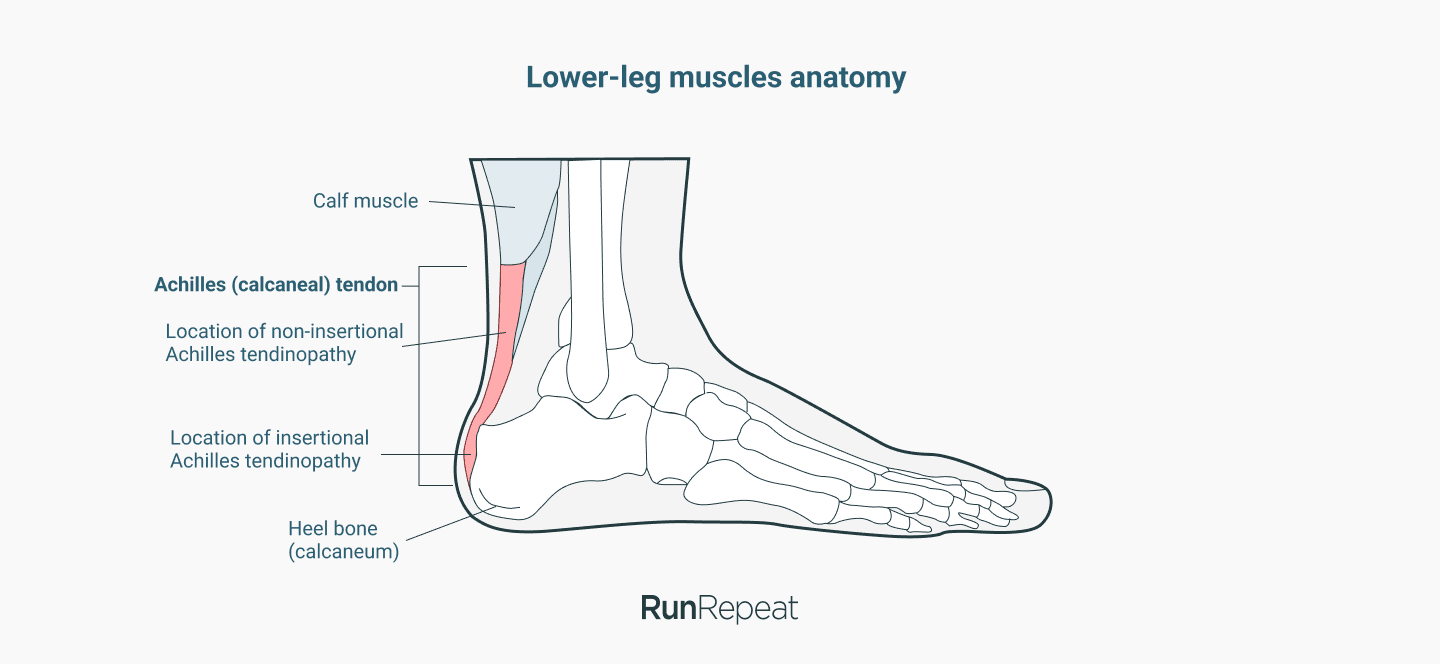
When runners experience AT, it’s usually non-insertional Achilles tendinopathy. The injury and pain occur around the middle of the tendon, which is why it is sometimes called midportion AT, and it mostly happens due to repetitive trauma (stress), exactly like running. We also have insertional Achilles tendinopathy, which occurs where the tendon inserts into the heel bone. It’s often caused by wearing the wrong footwear or having calcifications.
Based on a study that looked at 1,700 runners, the Achilles tendon injury is the 2nd most frequent one, with 23.5% runners experiencing it. It’s also interesting that the highest frequency of injury was found in runners who run in carbon-plated shoes (19.3%).
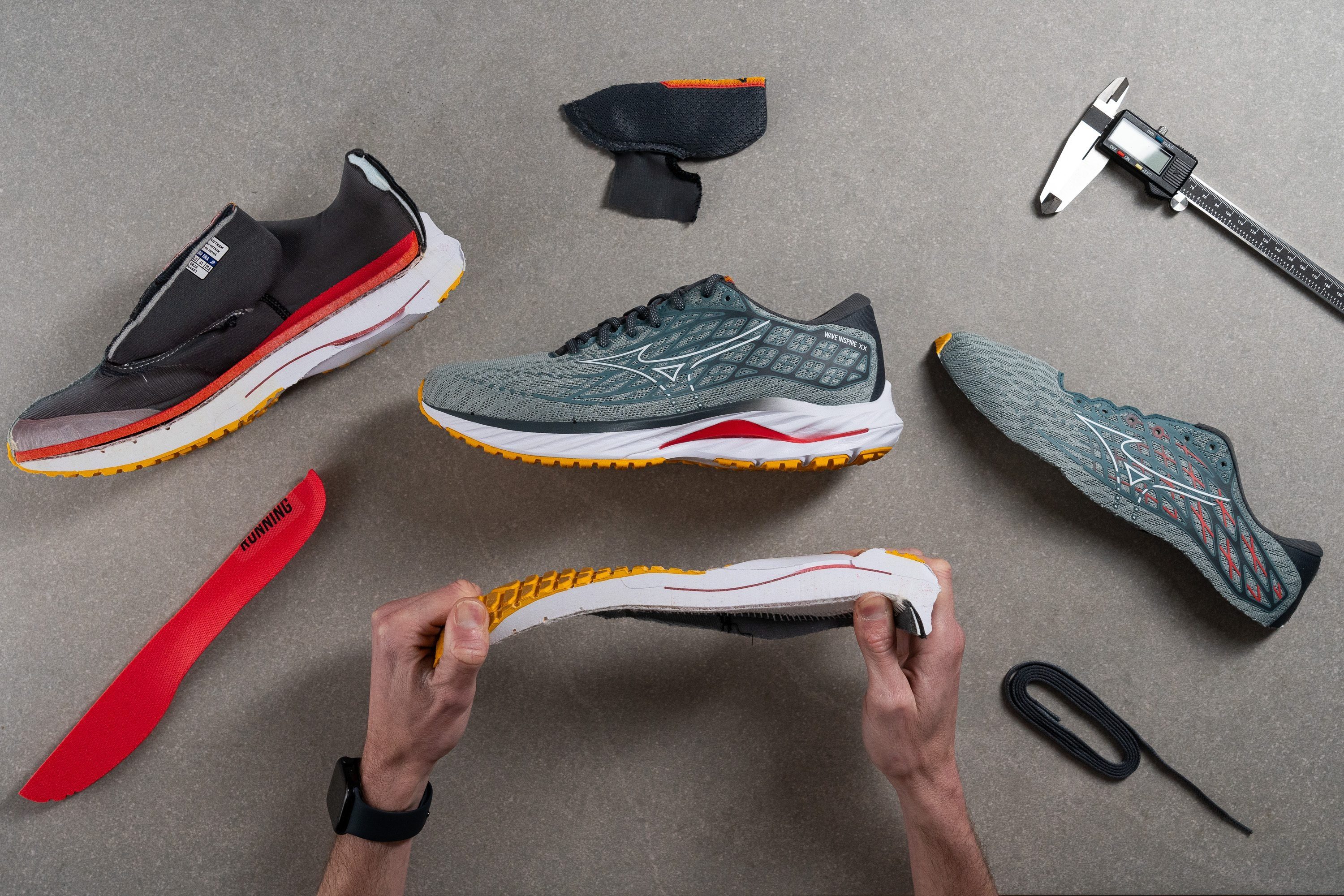
Just how important is Achilles tendinitis and why should you care about its healing process?
Not talking about the obvious - like not being able to move at all without our Achilles tendons - it’s also interesting that one study looked at the energy returned from the tendon itself and concluded it was higher in a stiffer shoe. The difference was very similar to those 4% Nike talked about: a 3.9% difference in the mechanical energy required per step. So, stiffer running shoes might improve the running performance because the energy returned from the Achilles tendon is increased!
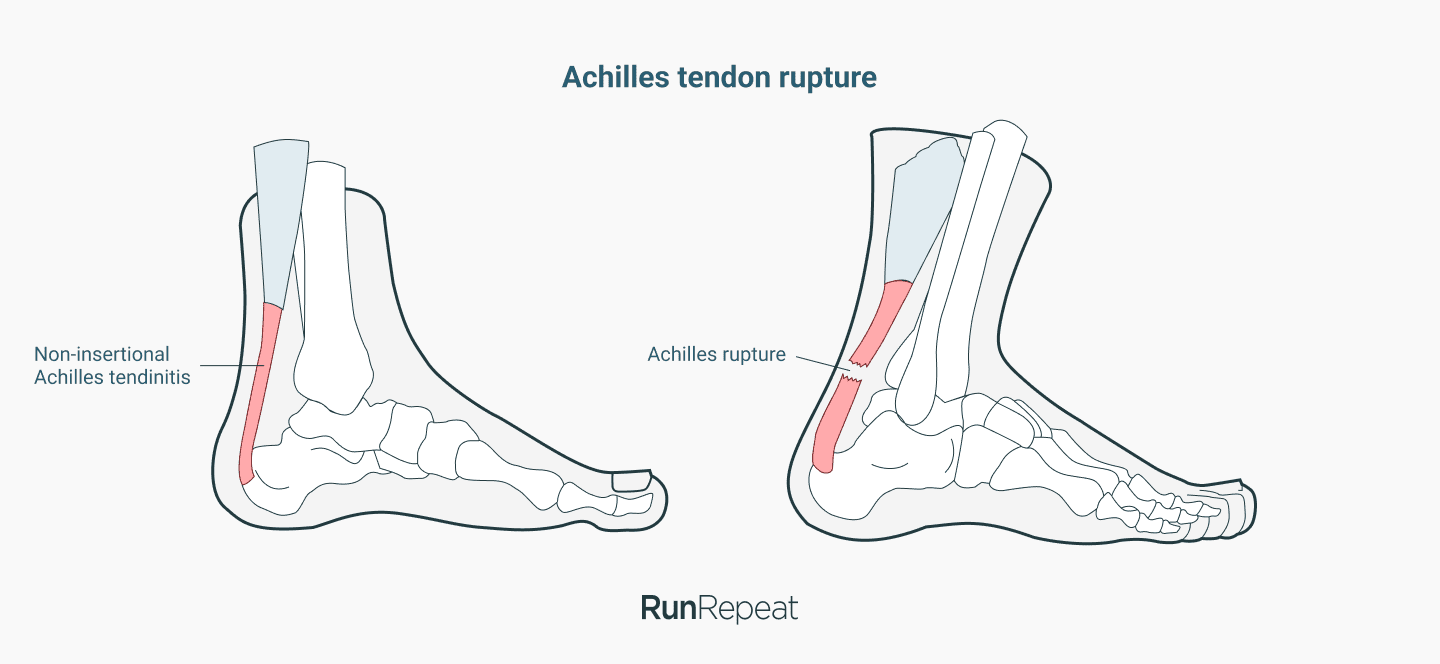
Even if you’re not into chasing PBs or running competitively, it’s important to focus on rehab and therapy because 5% of people with Achilles tendonitis end up with a tendon rupture as well. Then, it’s surgery time and, potentially, an even longer recovery period.
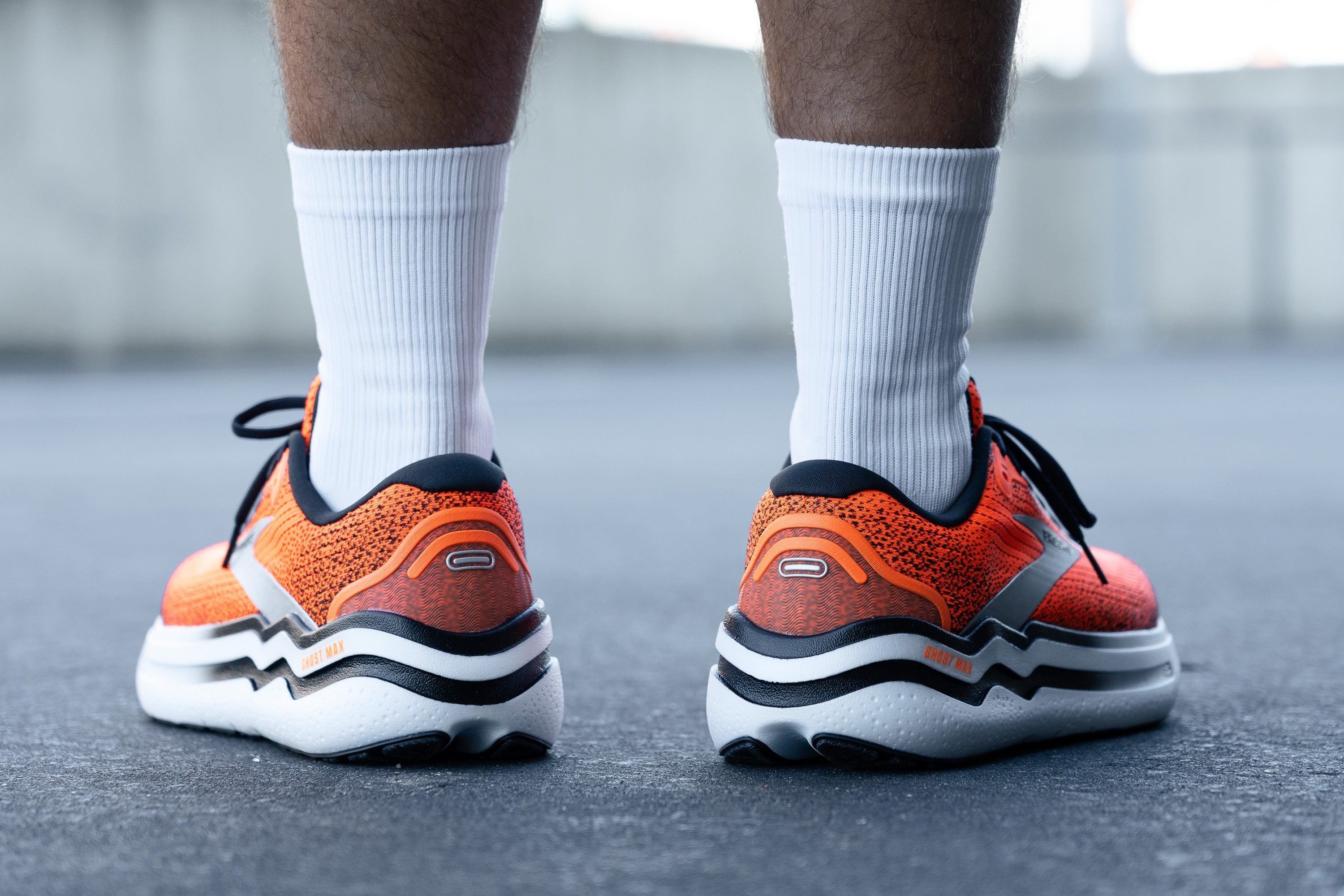
6 shoe features to look for if you’re experiencing Achilles tendinopathy
As mentioned at the beginning, rehabilitation is a priority when dealing with the AT. Sure, shoes can help to a certain degree which is why we will discuss the next features throughout the guide:
- Cushioned running shoes with good shock absorption (higher than 110 SA)
- High heel drop - 9mm or higher
- Torsionally rigidity - running shoes that scored 4/5 or 5/5 on our lab tests
- Stiff heel counters - heel counters that scored 4/5 or 5/5 on our lab tests
- Firmer midsoles - those that scored 20 or higher on shore A durometers
- Daily trainers without a carbon plate - avoid tempo and race shoes.
1) Protective running shoes for Achilles pain are great for heel strikers
If you’re experiencing Achilles tendinopathy, we recommend using running shoes that have shock absorption higher than 110 SA (we classify these running shoes as cushioned). Having foam below your heels that is protective (it's great at dampening the impact forces at the landing) feels good because less stress is sent from the heels to the Achilles tendons (and other parts of the legs) that way.
Measuring shock absorption in RunRepeat lab
To measure the shock absorption, we honor the ASTM F1976 13 methodology, a golden standard this area! We drop an 8.5kg mass from a height of 50mm, with a total energy input of 5 J. Althought we test this both at the forefoot and the heel, you may be curious about the heel numbers more, given our foot strike.
Why minimalist/barefoot running shoes could be bad for you
If you are a heel striker who runs in cushioned running shoes and you intentionally switch to minimalist or barefoot running shoes and, therefore, change your foot strike to the forefoot one, this change may increase the risk of tendinopathy. Another study confirmed this, showing that, for heel strikers, the peak Achilles tendon loading rate is significantly higher in minimalist shoes than cushioned shoes.
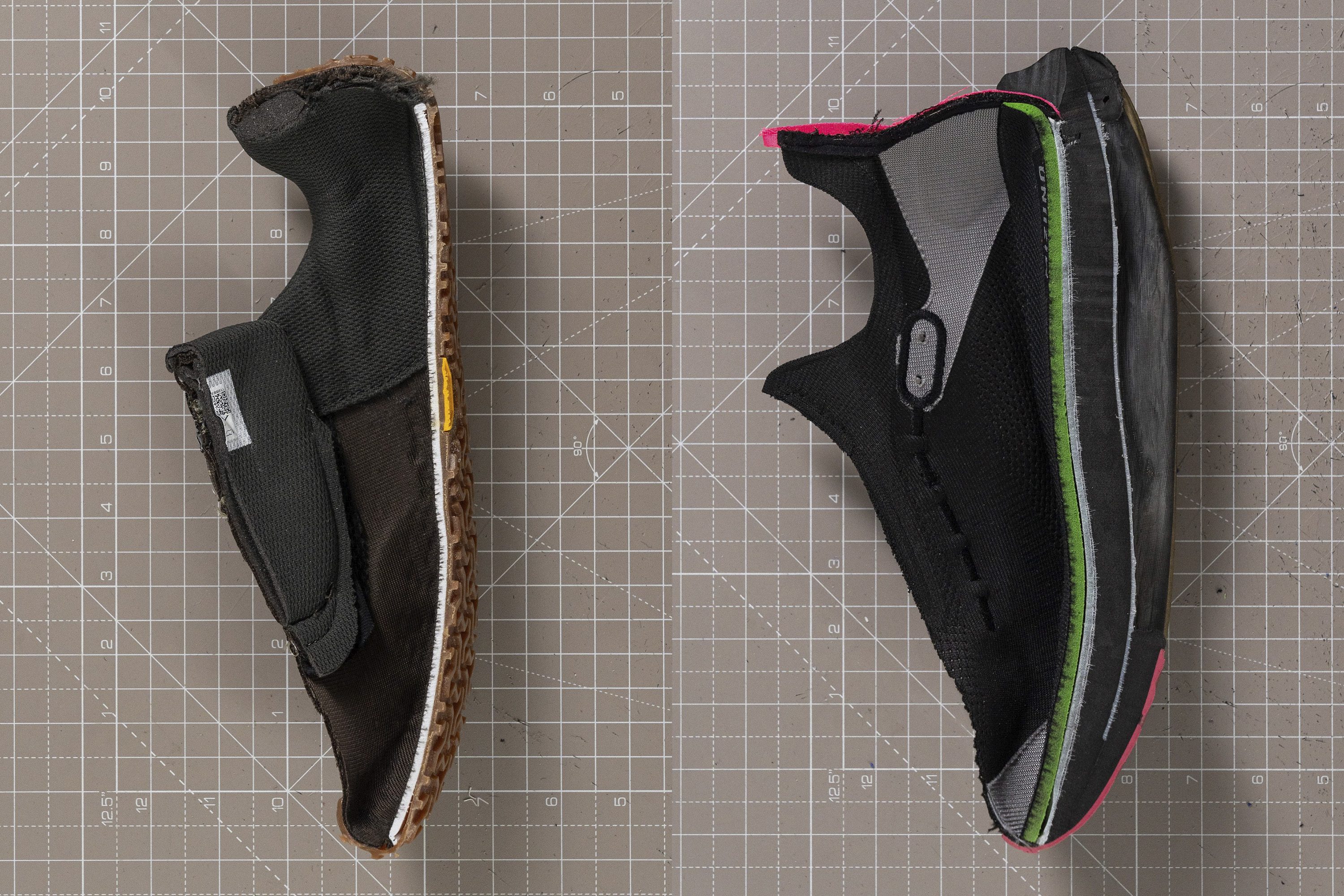
Why forefoot strike is good AND bad for Achilles tendinopathy
A few bullets you should know when it comes to the foot strike and Achilles tendinopathy:
- The majority of runners who experience painful Achilles are forefoot strikers, which makes sense given that the forefoot strike puts the most stress on the Achilles tendons, as found in this study.
- The majority of AT-affected runners run in carbon-plated shoes, which makes sense as most carbon-plated shoes are made for fast runs and forefoot strikers. Slower runs are actually better for the Achilles so no wonder fast shoes made things worse.
A forefoot strike can do your Achilles both good and bad. It depends on your goals.
The bad
If you’re already experiencing Achilles tendinopathy, forefoot strike may harm you even more. Many studies have shown that forefoot strikers put more stress on the Achilles tendons (1, 2, 3, 4, 5).
One study looked at 550 runners with running-related injuries and found that midfoot strike had the highest correlation with Achilles tendon injuries.
The good
What many of these studies also show is that a gradual transition toward a forefoot strike can help with strengthening the Achilles tendons which is important if you want to prevent (another) injury. It’s important for the transition to be gradual so that your whole body adapts to the new strike and what it brings - different landings, toe offs, foot muscles being activated (much) more, higher-leg muscles being utilized less, your overall body position, etc.
2) Higher heel drop is recommended for Achilles tendonitis
We recommend a heel drop of 9 mm or more. This higher drop usually means a heel strike because there’s a lot of foam at the back that can come between you and your forefoot strike, so you land on the heel. But, it also means that higher-leg muscles are utilized more!
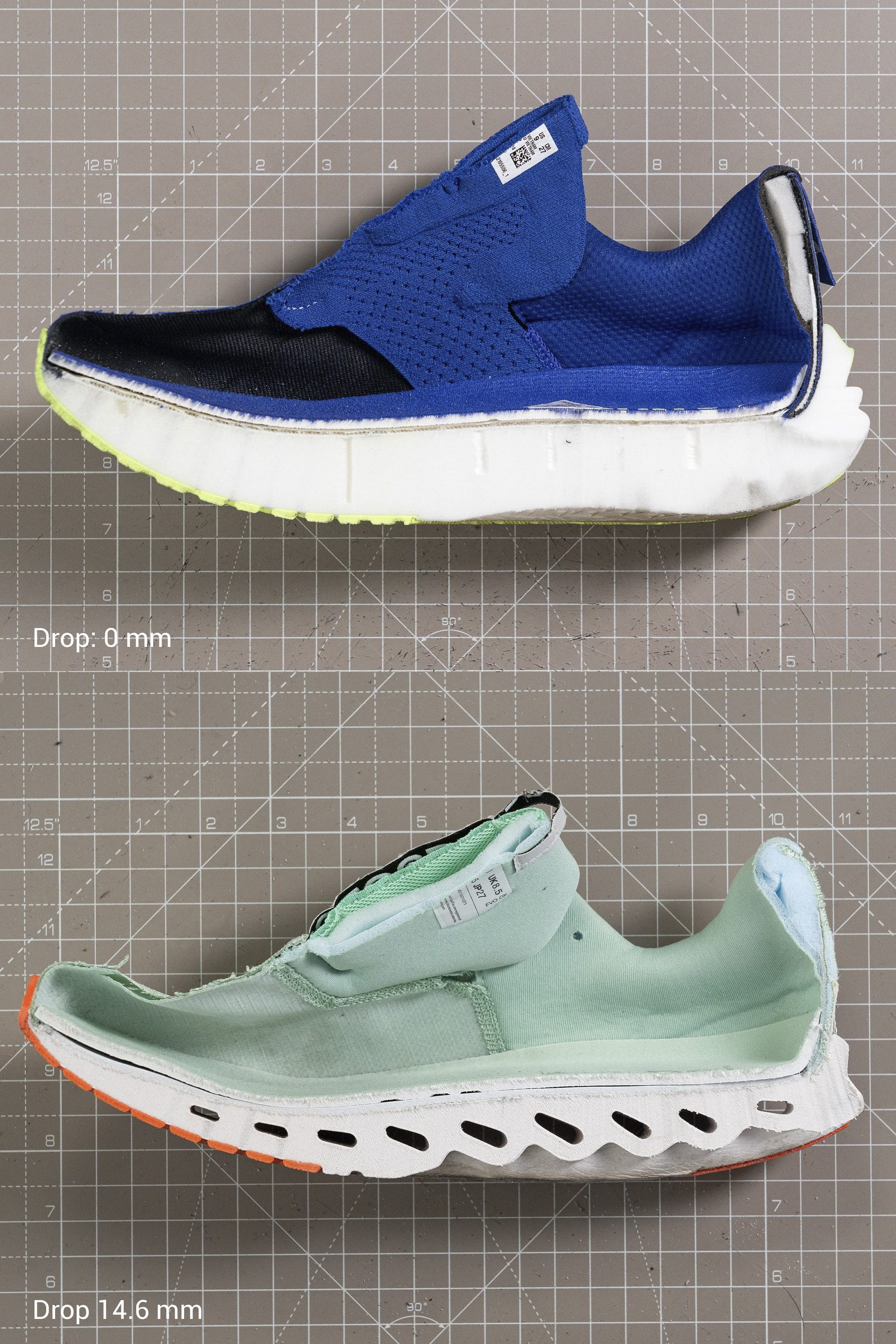
Thanks to our stack height measurements, we calculate the heel drop by subtracting the forefoot stack height from the heel stack height.
In contrast, in zero- and low-drop running shoes, more stress is put on foot muscles and lower-leg muscles. And that’s exactly why we recommend higher-drop shoes, to let the Achilles tendons work less and let the thighs, hip muscles, and glutes work more.
We have covered this topic (heel to toe drop and it’s effect on runners, be it a foot strike or muscle use and injuries) in great detail in our guide Heel to Toe Drop: The Ultimate Guide. We highly recommend reading it!
|
One study focused on the heel drop specifically by using 2 cm heel lifts. The study showed that the lifts immediately reduced the pain in people with insertional AT and that they significantly improved symptoms after 2 weeks of wearing the lifts. |
3) Torsional rigidity is good for AT
Torsionally rigid running shoes are those shoes that you can’t twist easily. They fight back. As a contrast, torsionally flexible running shoes are twisted easily and a lot.
Shoe that got a 4/5 torsional rigidity rating
Shoe that got a 1/5 torsional rigidity rating
For painful Achilles tendons, we recommend rigid running shoes. Ideally, those that scored 4/5 or 5/5 on our assessments. And here’s why, such shoes won’t have your feet wobbling on uneven surfaces, when cornering, and similar. They will give extra support and stability that are much appreciated by the Achilles tendons!
It’s important to note that, while shoes can be quite torsionally rigid, they can still be longitudinally flexible. This flexibility helps with the natural running feel because our feet are flexible on their own and many runners prefer a similar feel, not a stiff platform (like many approach shoes and hiking boots have).
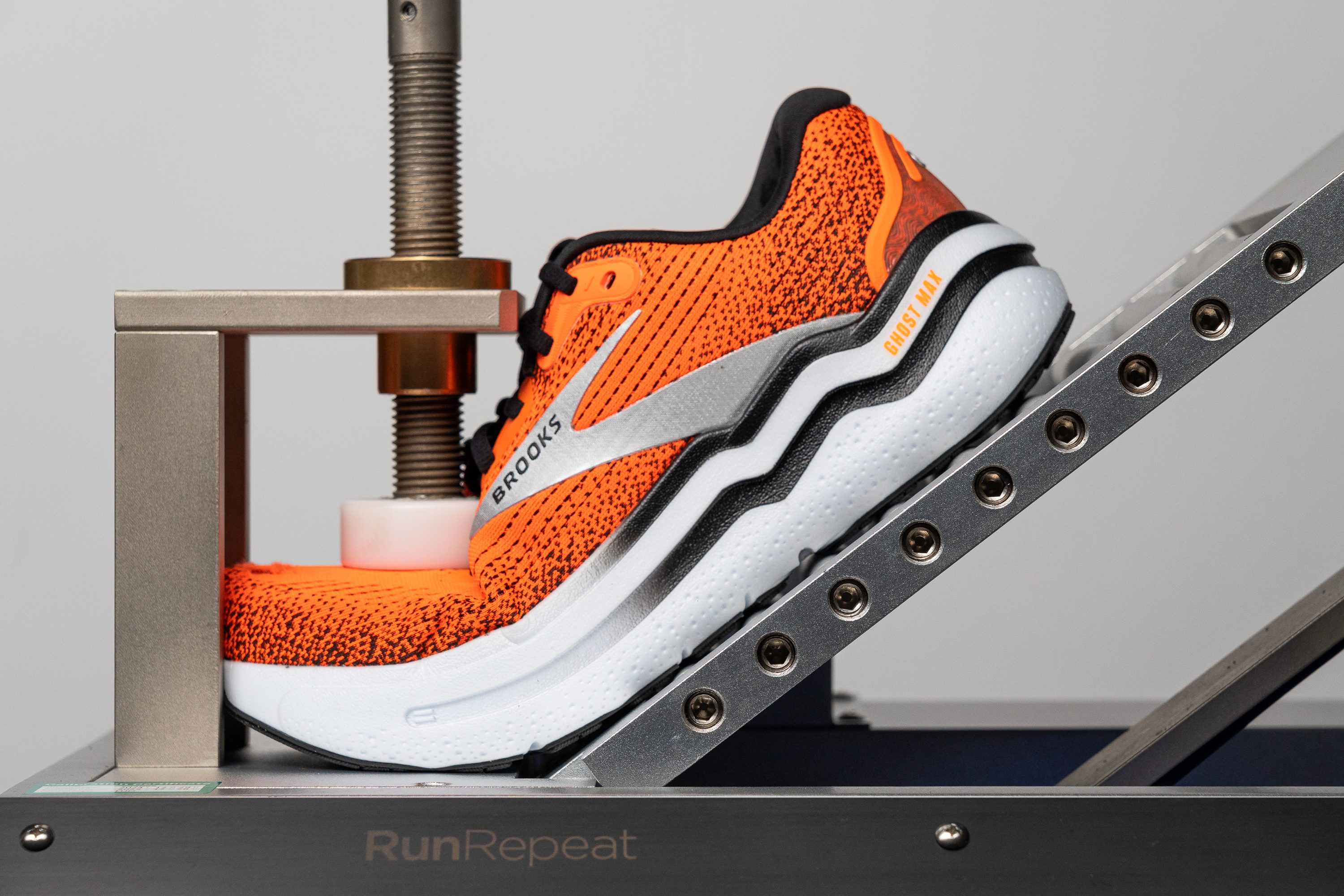
In the lab, we use a machine to clamp the forefoot to the surface, adjust for the rocker, and then bend the shoe 30 degrees. The more force the machine needs to do that, the stiffer the shoe and the higher the number on the display. Knowing this, it’s easier to decide how rigid and stiff/flexible you want your platform to be.
4) Stiff heel counters but not harsh heel cups
Stiff but not harsh? What we mean is actually heel counters that offer support but do not hurt your heels and Achilles even more. To cradle the heel, running shoes often have a lot of padding.
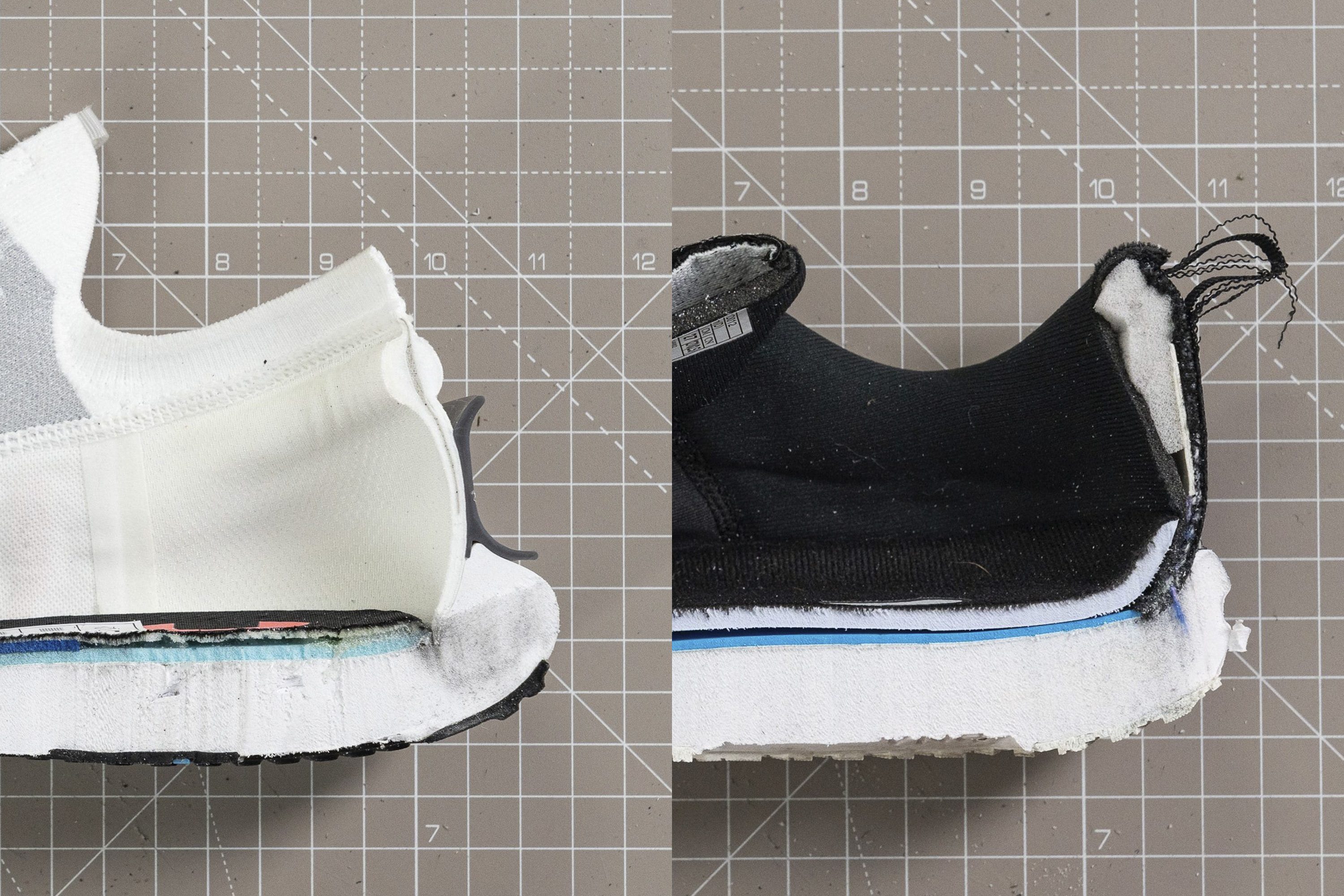
Now that we know your heels should be hugged, that hug should be firm. This means that the heel counter should be stiff. The stiffer it is, the better the lockdown of the heel. This immobility makes the tendons work less or, at least, not overwork.
This heel counter got the highest rating: 5/5, meaning it is as stiff as it gets
This heel counter got the lowest rating: 1/5, meaning it is as flexible as it gets
We found that the heel counters who scored 4/5 or 5/5 give the best support for painful Achilles. This stiffness comes from internal and/or external heel counters. Internal ones are noticed when shoes are cut in half and external ones are easy to see.
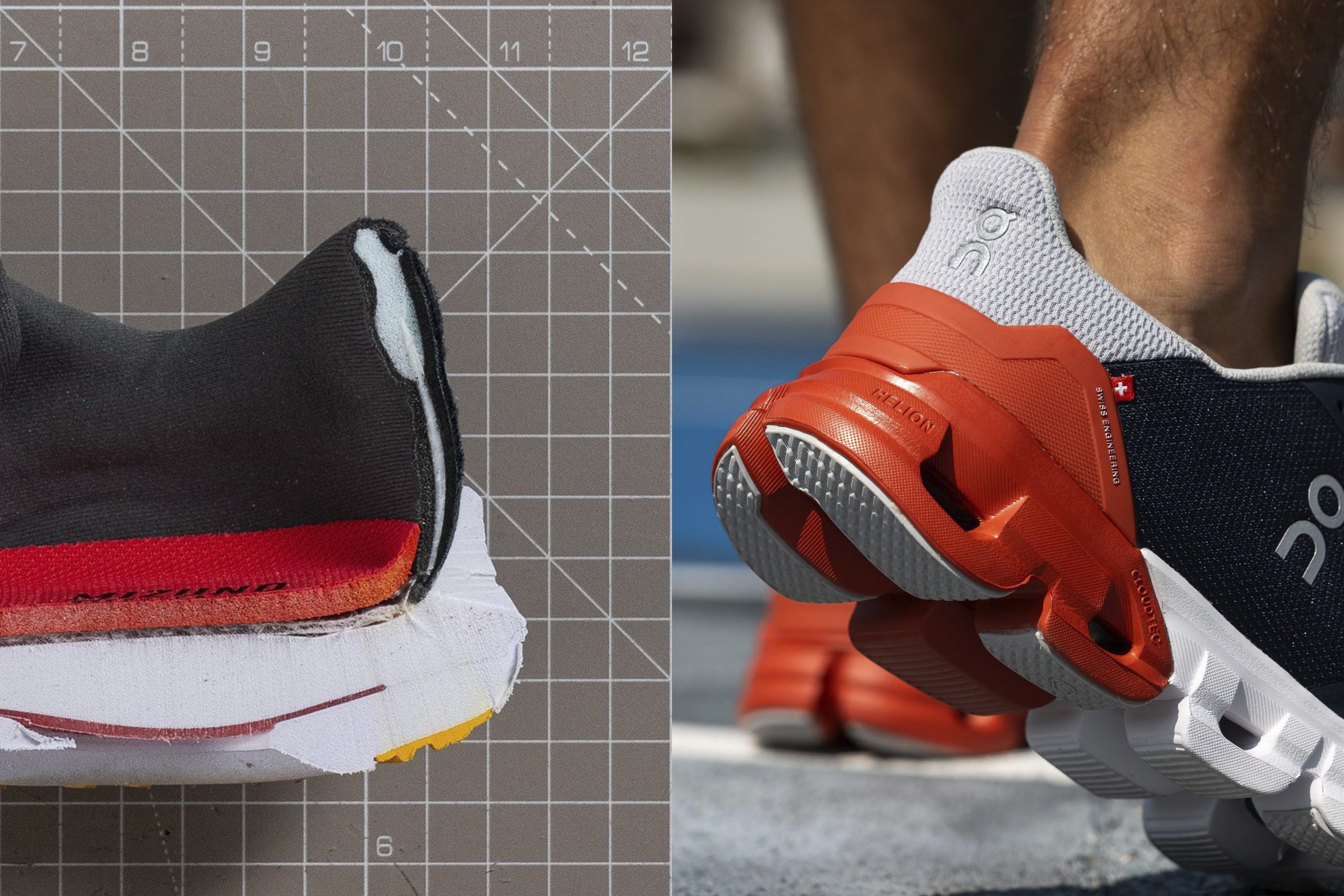
Padded and stiff is usually a great combination, until it isn’t. Even with the padding, some heel cups can be very harsh and irritate your tendons.
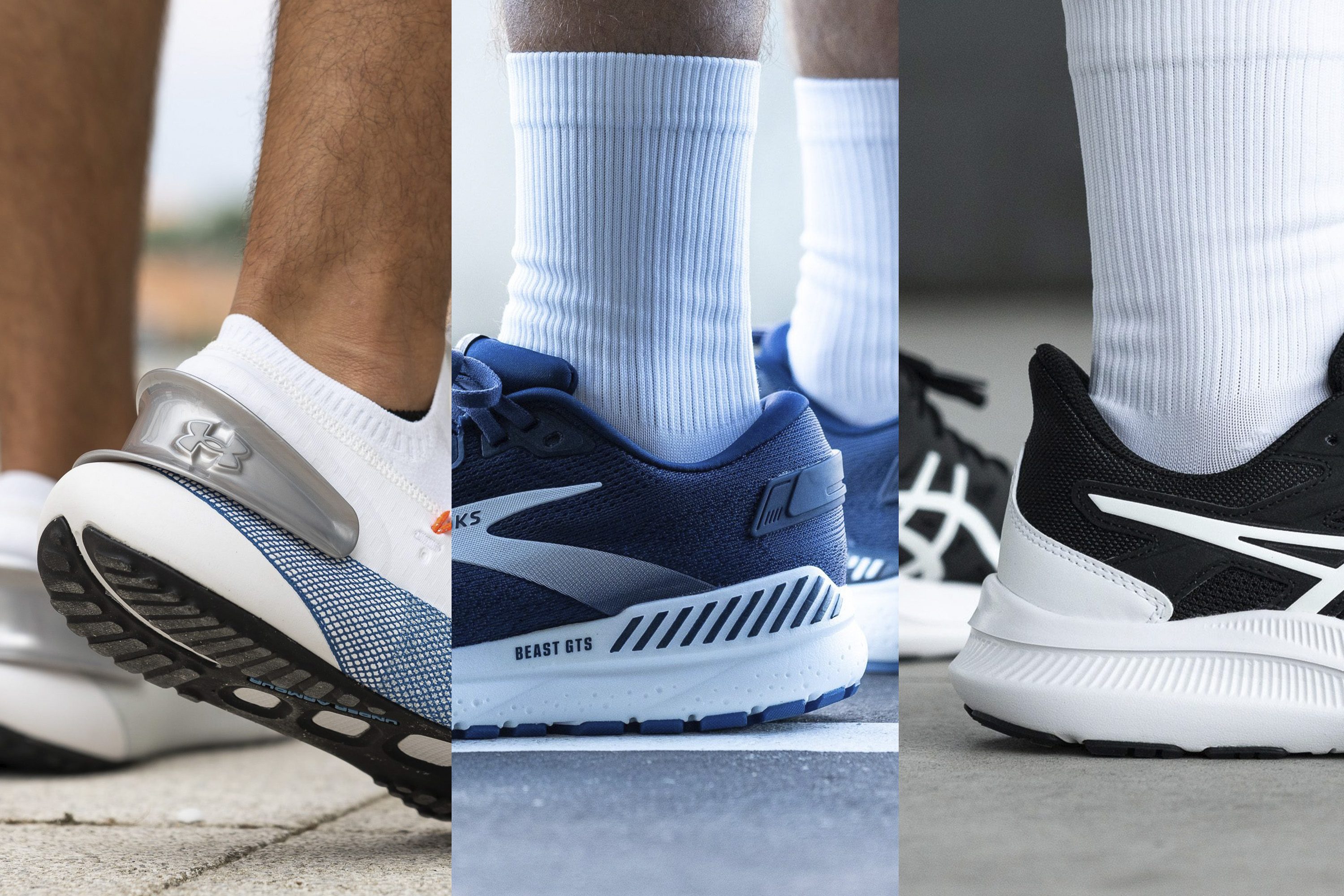
If you notice discomfort in this area, we recommend choosing a different pair of shoes.
5) Extremely soft midsoles are a NO
Some foams are very soft and they feel great but, in the long run, they are not so great for Achilles tendinitis. Softer foams also mean more movements and more muscle work in our feet, however small. That’s why we recommend slightly firmer foams: those who got at least 20 on the shore A durometer.
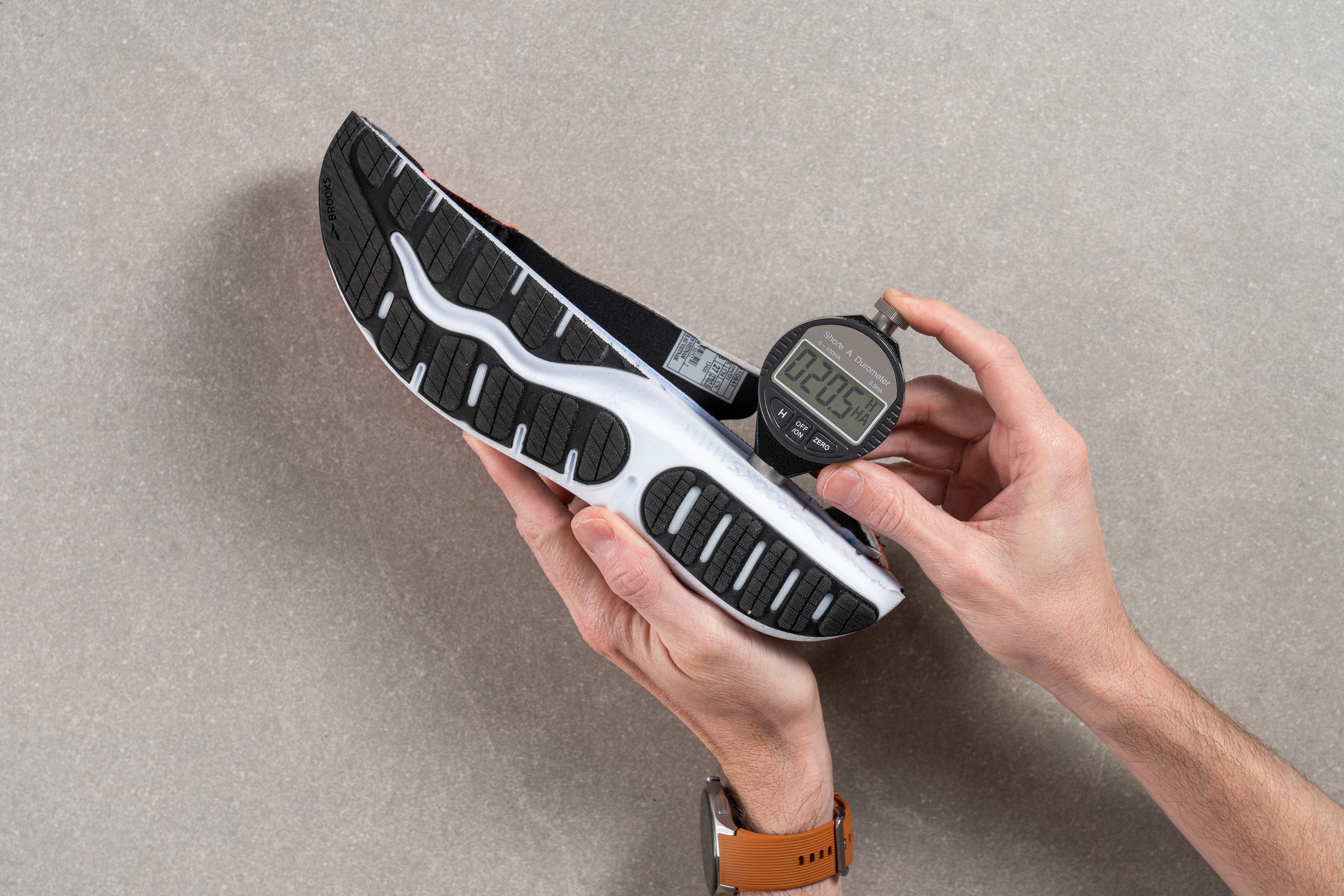
We always perform this test on running shoes cut in half because the durometer needle needs to be stuck into the raw foam. If we were doing it on the outside, on shoes that are not cut in half, the numbers would also reflect protective overlays, colors, and similar factors, and the results would be wildly inaccurate.
Given that the current midsole softness average for road running shoes sits around 20 HA, this is not a big restraint, but more like a word of caution.
Keep in mind that we measure the softness of the midsole itself. Many running shoes for painful Achilles feature a cushy insole.
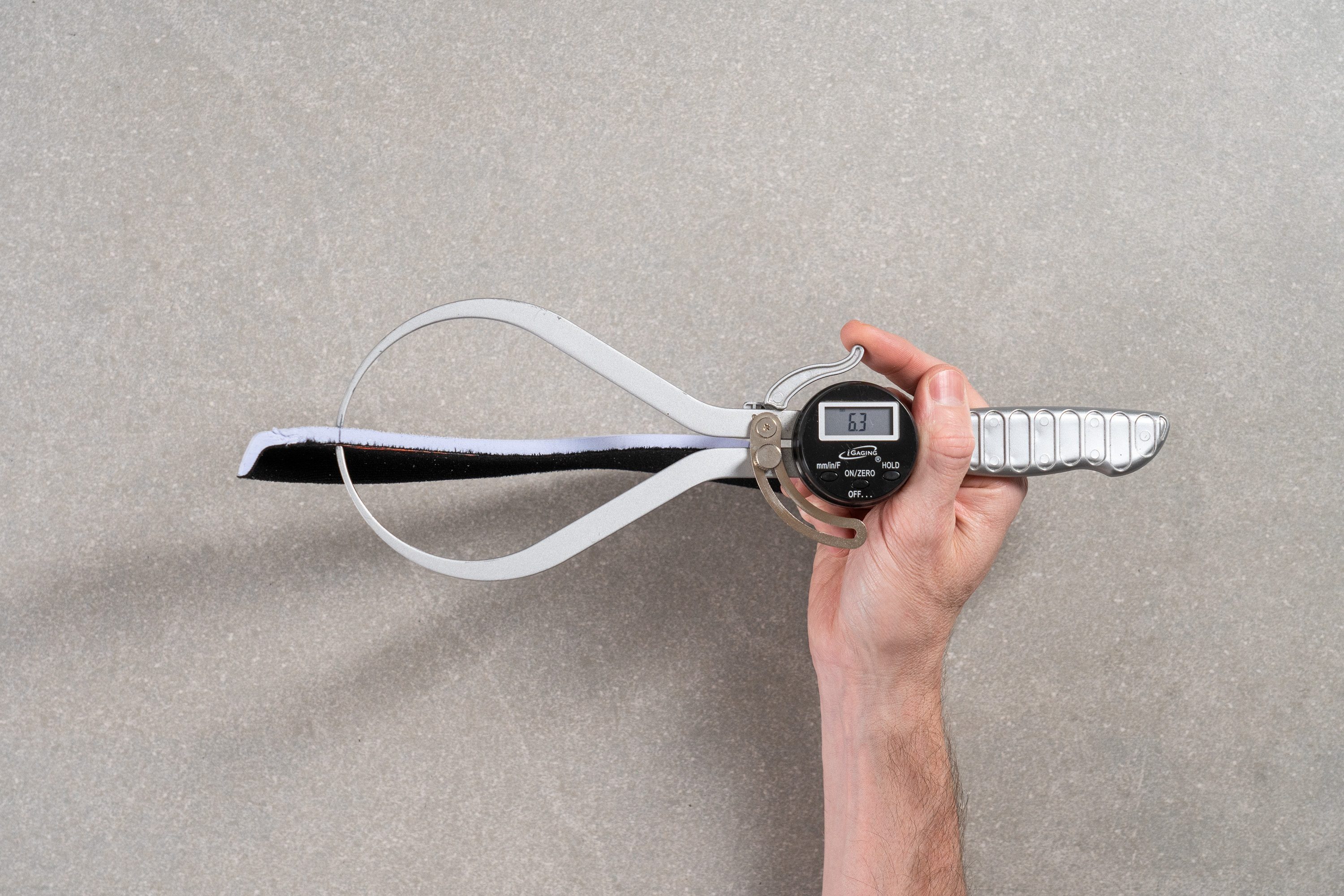
If this is your cup of tea, here’s a selection of shoes with the thickest insoles:
6) Running slower can help with Achilles tendonitis
Running at faster paces seems to increase the stress on the Achilles tendons for heel strikers, as shown in this study. Specifically, the study looked at the runners running on a treadmill at 2m/s to 5m/s.
If you own tempo and race shoes, it might make sense to move to the daily trainers while recovering from Achilles tendonitis. We also recommend shoes with no carbon-fiber plates when you’re dealing with Achilles tendonitis.
Rocker technology might help runners dealing with painful Achilles
When researchers worked with people who have been suffering from non-insertional Achilles tendinopathy for at least 3 months (although the average duration was 22.5 months), they discovered that rockered shoes reduced the plantar flexion moment by 13%, both when walking and running. The Achilles tendon load rises proportionally to the plantar flexion moment, which is why this is related to Achilles injuries.
This 13% reduction is significant and tells us that rockered shoes might help runners dealing with Achilles tendinopathy.
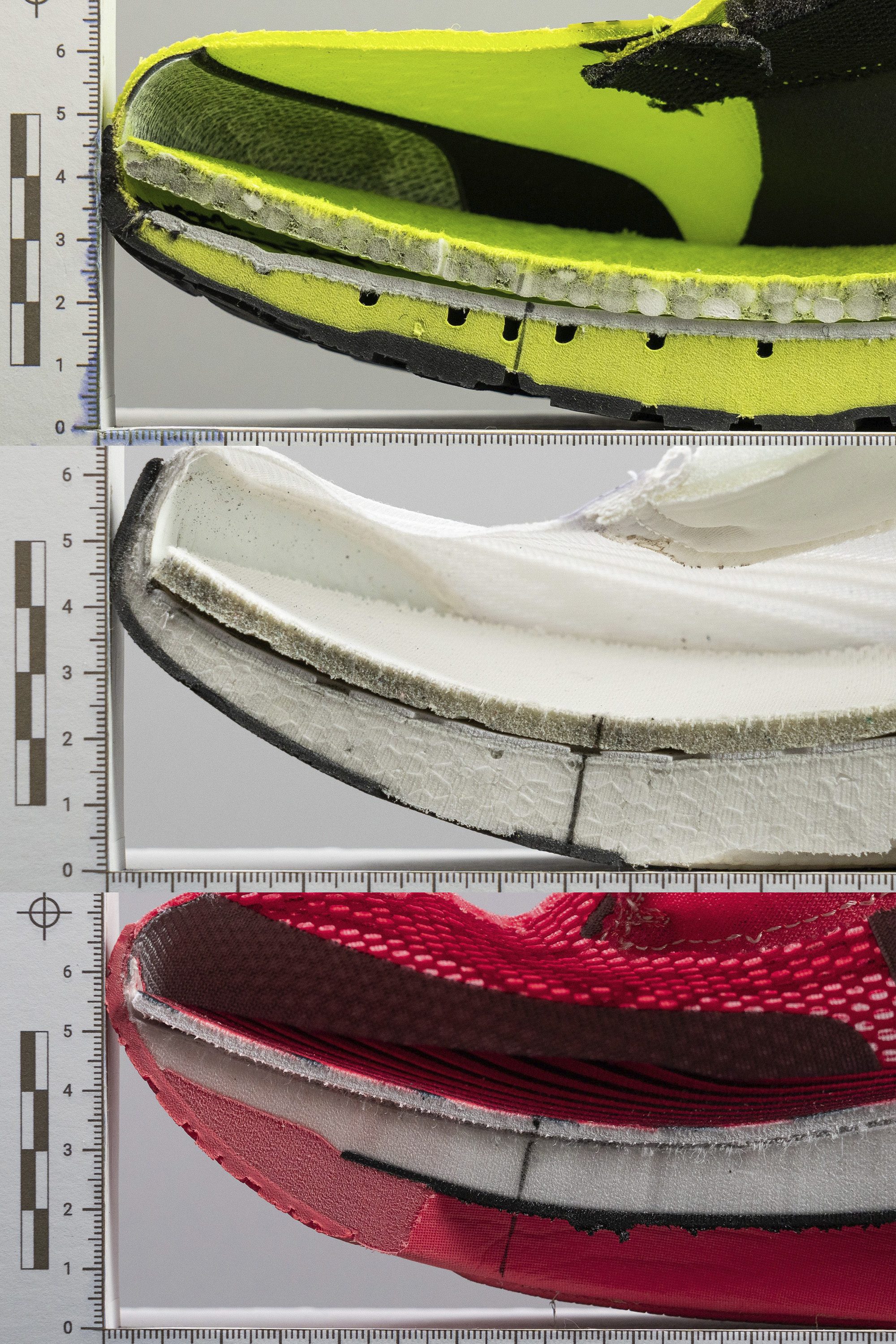
Rockered running shoe rocks back and forth smoothly, unlike those with no rocker that just fall flat onto the ground
Arch support in running shoes for Achilles tendon pain
Regardless of the foot condition, runners still overpronate (or not). In case you do overpronate, you might enjoy the support and stability that is found in stability running shoes. These running shoes are made for runners whose ankles collapse inward at the landing, which is why they use the inner side of the shoe more, which can be easily noticed when looking at the bottom of the shoes.
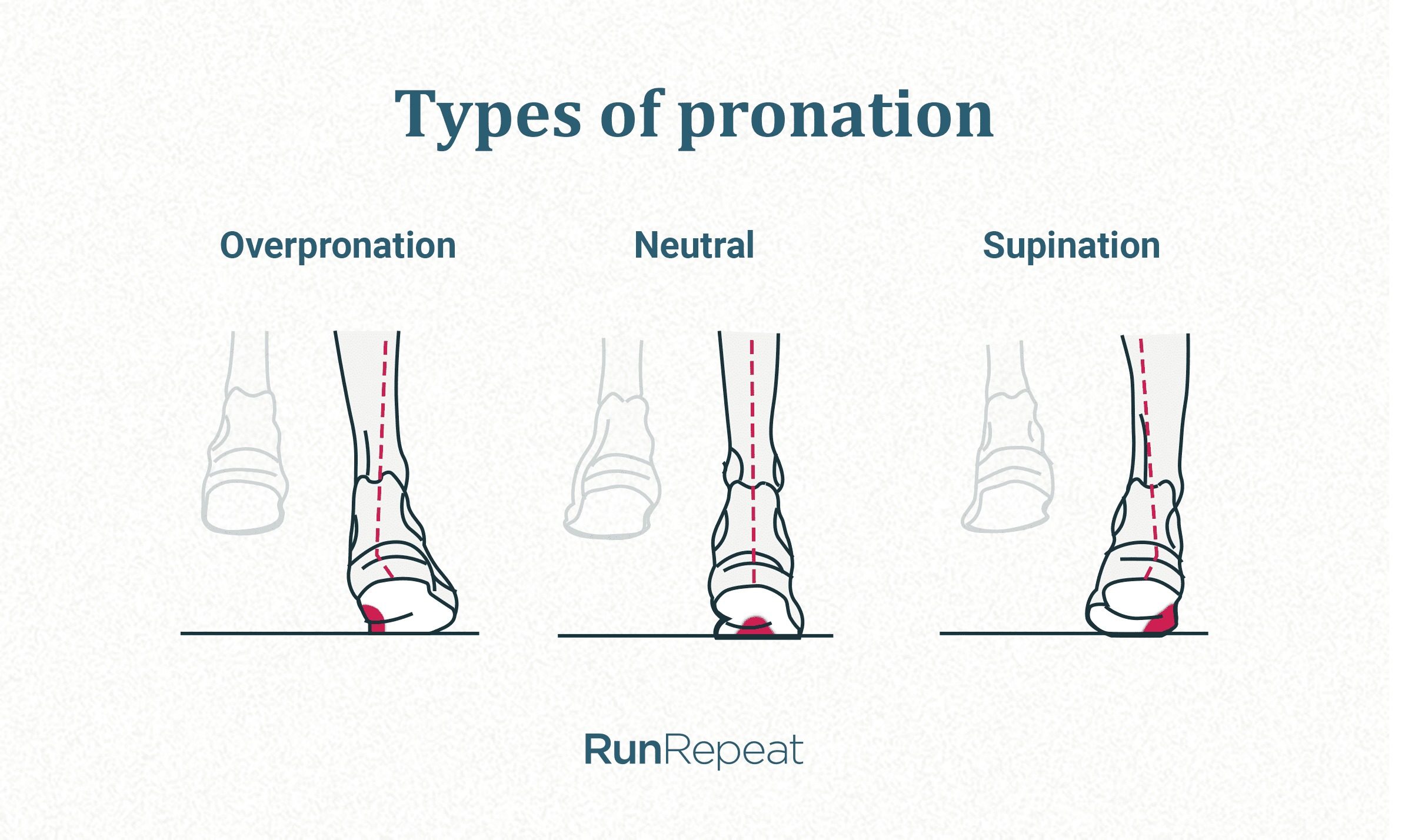
The majority of runners who overpronate have flat feet.
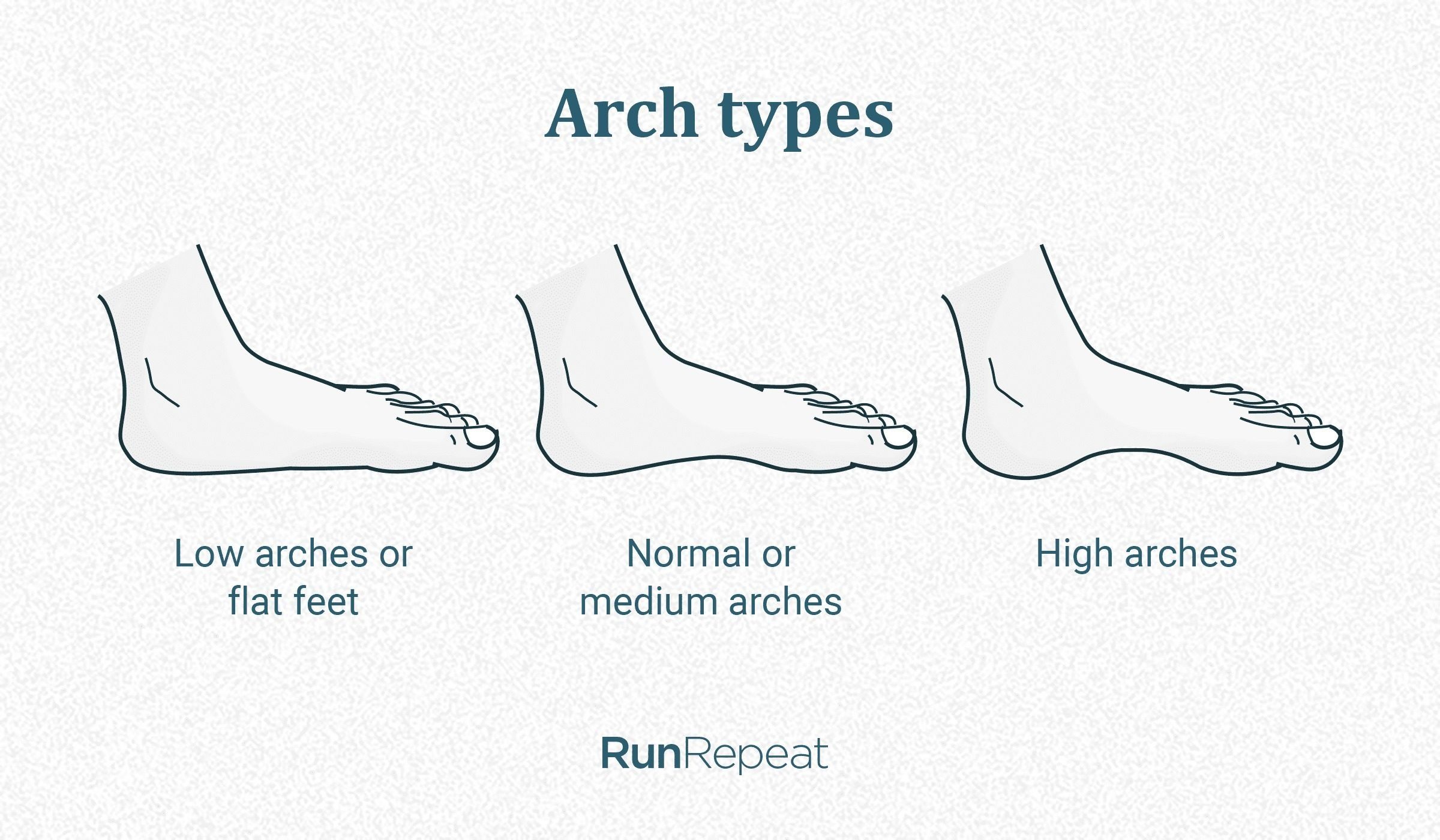
Running shoes that are made for overpronators offer extra arch support by integrating a) trademarked technologies, or b) geometrical shoe elements. These running shoes are always clearly marked as stability shoes and brands love promoting these specific elements.
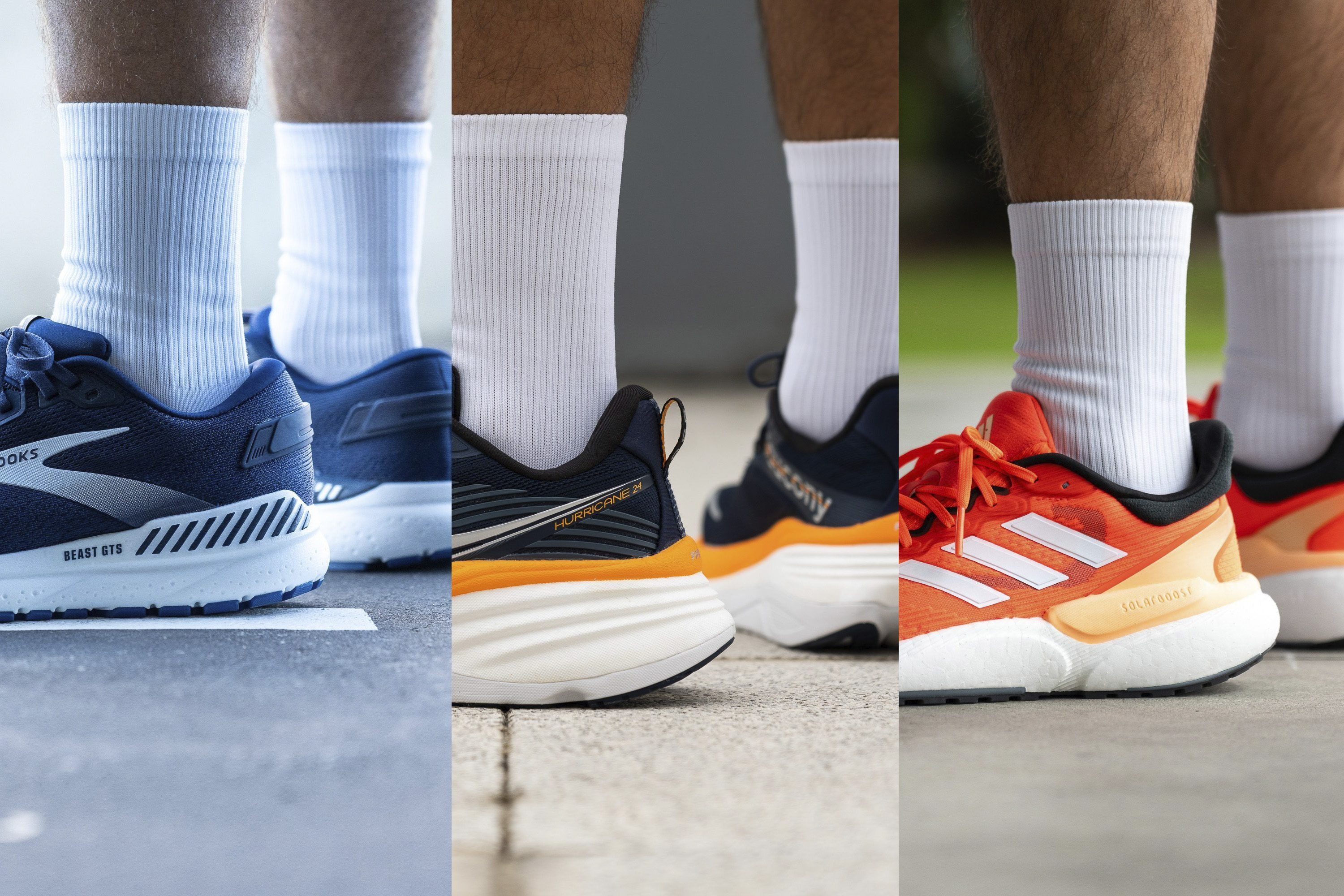
Super-stable running shoes for AT
One of the features that makes all running shoes stable, regardless of the pronation, is a wide platform. This is something we always measure in our lab so you can always check the numbers and compare to the averages, at least.
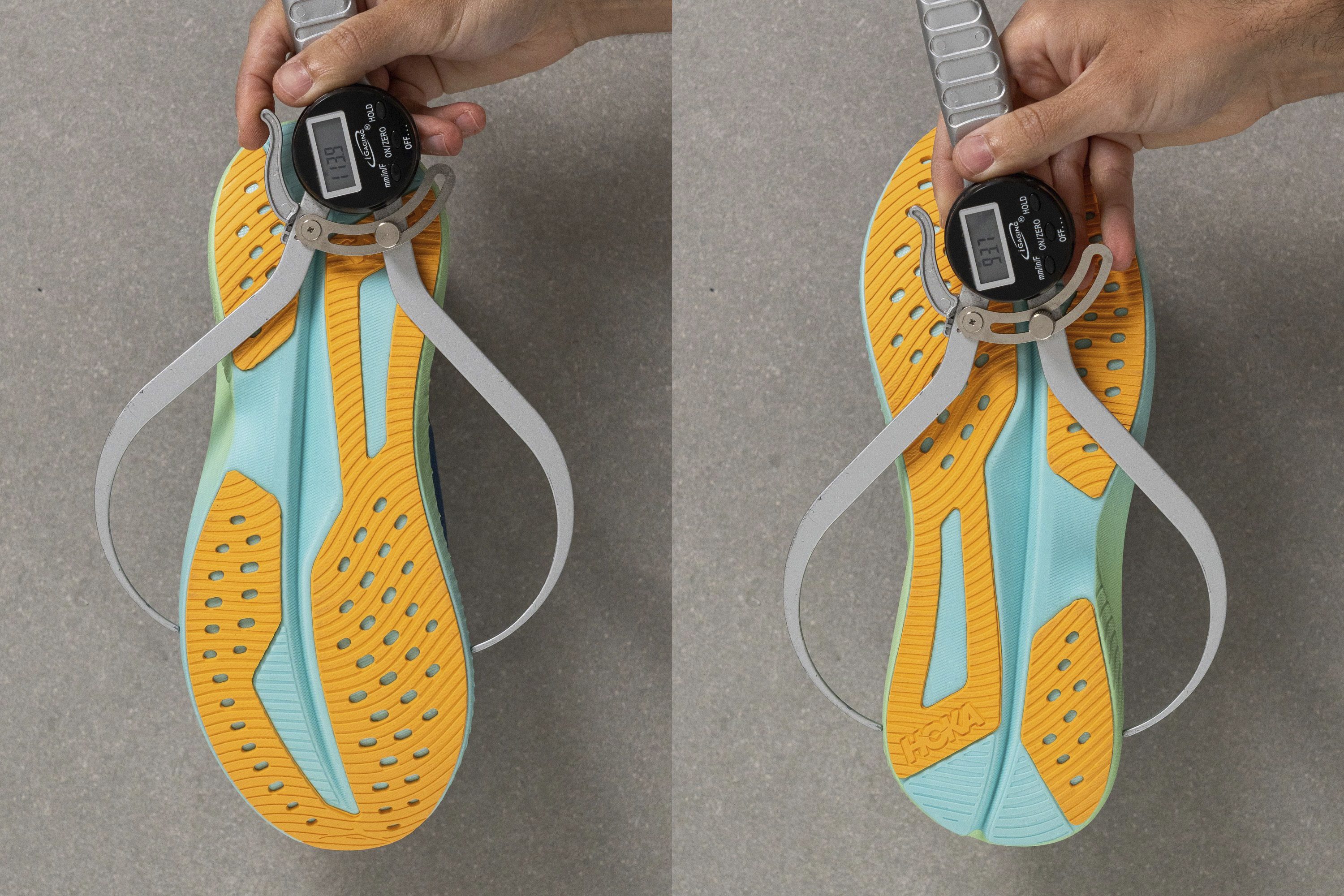
Daily trainers often have a wide platform, unlike race-day shoes which are narrow and often so tall that they are unstable.
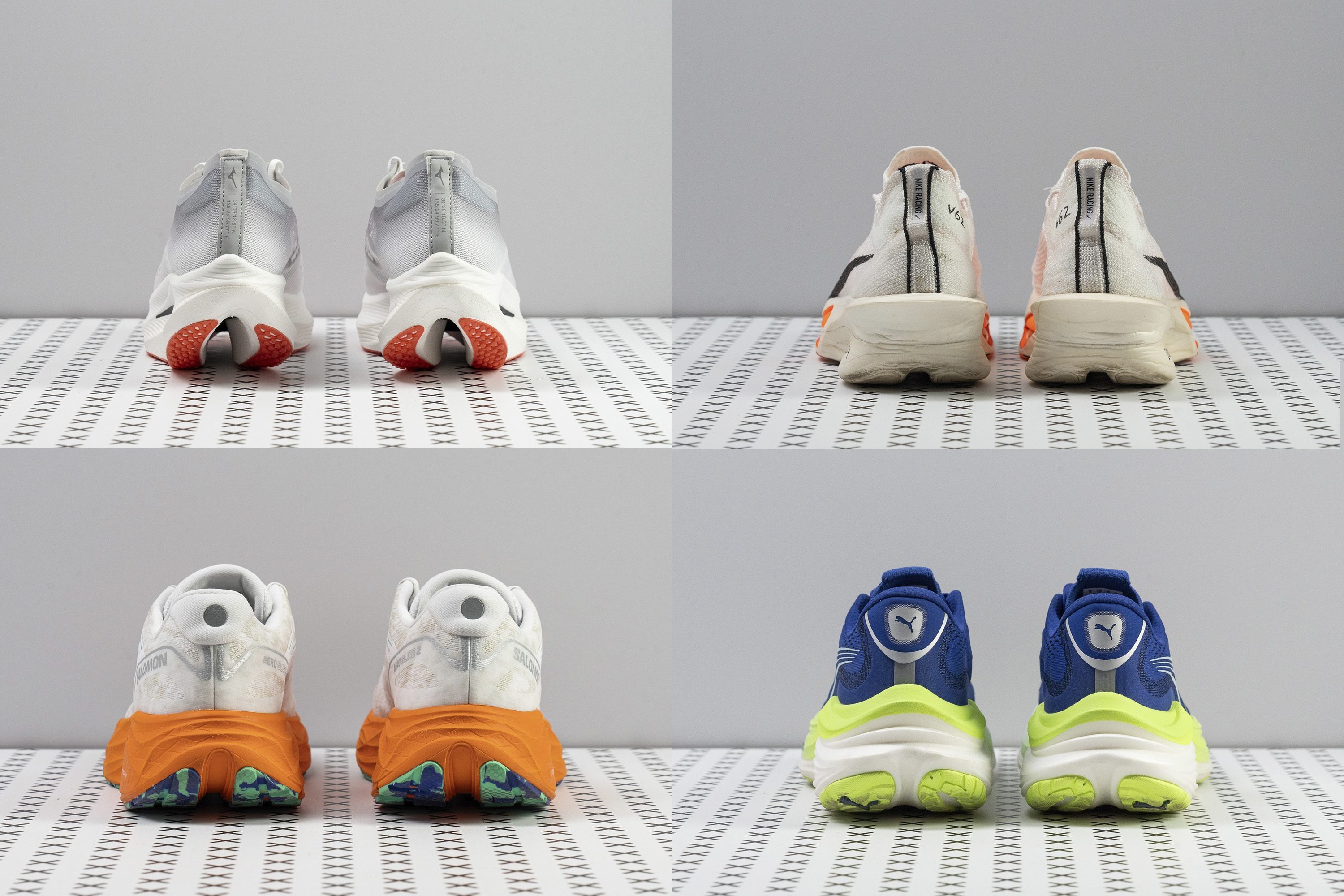
If this stability matters to you, look for the widest platforms found in running shoes for painful Achilles tendons.
Wide, narrow, or a tall toebox?
We all have different needs because we all have different feet and toes. Here, we offer running shoes for Achilles tendonitis that have a wide toebox, a narrow toebox, and a tall toebox. While the first two might be self-explanatory, the 3rd option is here because no one should have black or bleeding toenails!
In our lab, we pour gel into the shoe and freeze it to create a perfectly fitting cast. This allows us to precisely measure the volume of the toebox
Once the cast is ready, it is easy to measure the width of the shoe and the width of the toebox.
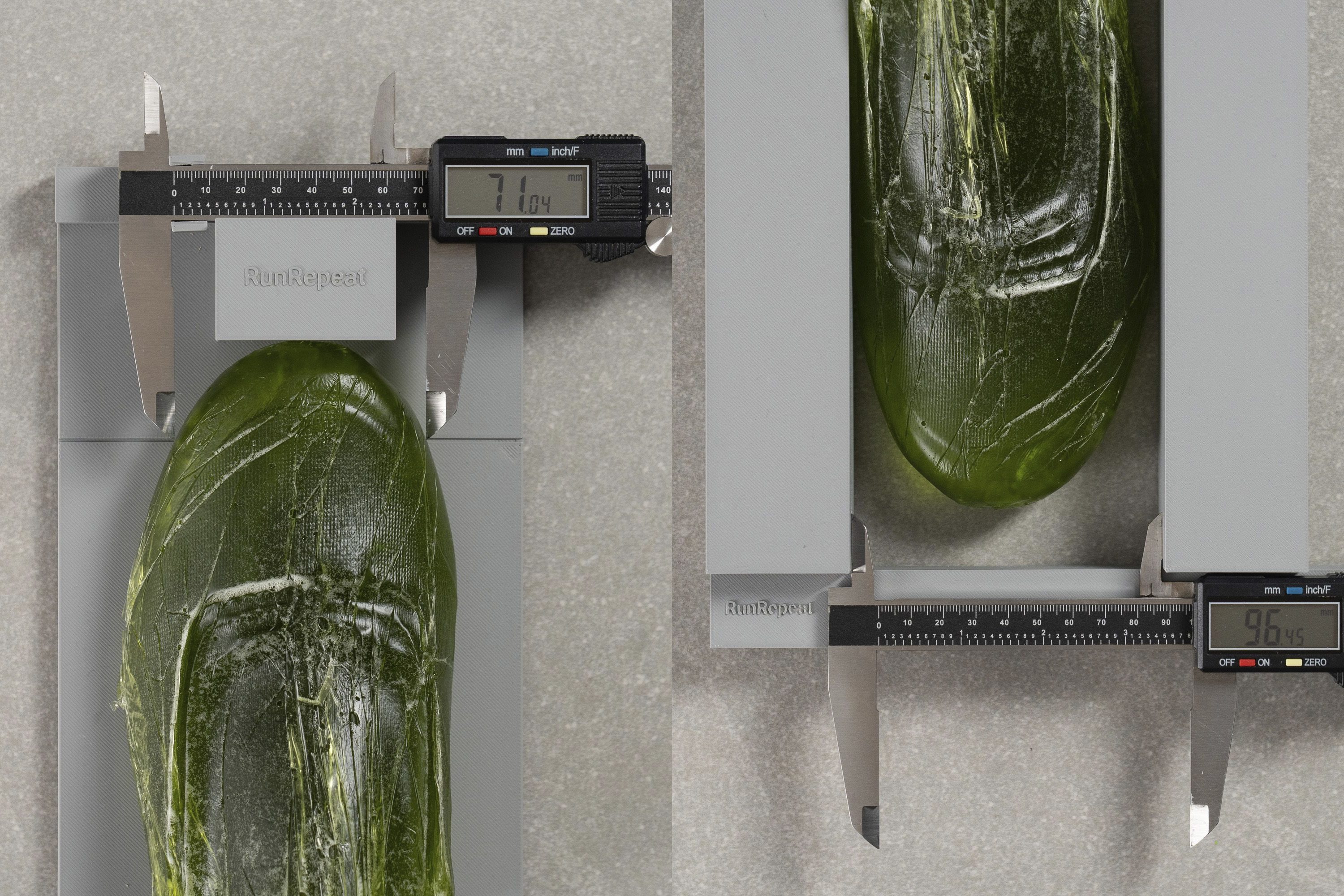
Given that you may need more room around the ball of the foot or at the big toe, we will offer both options.
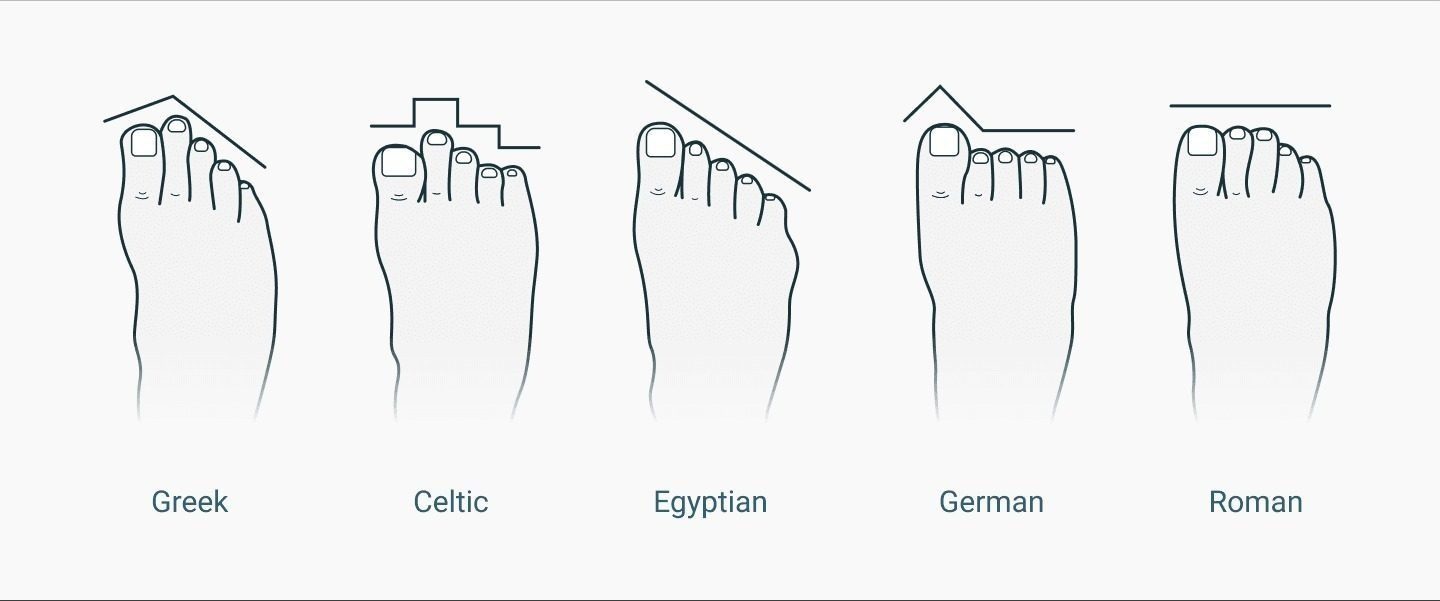
If your big toe is pointing up, look for more vertical space in the toebox.
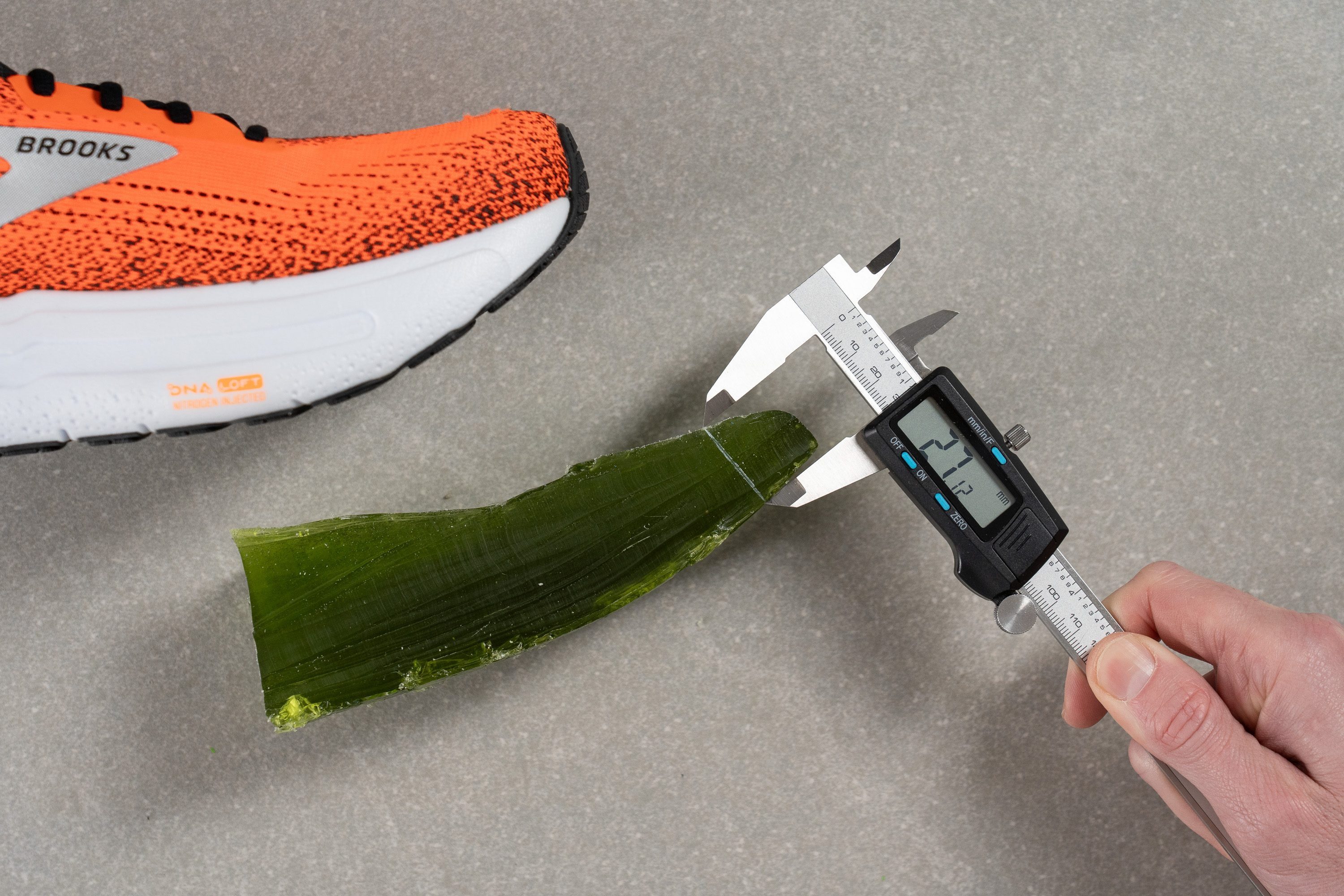
Avoid a lace bite when dealing with painful Achilles tendons
We all know a superb lockdown is a must when running. However, when runners struggle with painful Achilles, they might tighten the laces even more, because they want to be extra sure that their heel won’t slip or that their feet won't do any extra work. This may lead to a lace bite though.

If you’re one of these runners and you feel like you need thicker tongues for tighter knots, these running shoes have the fattest padding in the tongue that you may enjoy:
What happens if you keep running with the Achilles tendinitis
We’ve all been there. There’s a race you want to participate in, and the Achilles start flaring up. But you really want to do the race, maybe even at the cost of harming your Achilles tendons even more. You try to calm them down with ice packs. But the pain persists.
So, what will it be, ibuprofen or rest+rehab?
If you keep running through the pain, 3 things may happen:
- Injuring the tendons even more (more pain, more rehab needed)
- Injuring the tendons to the point where they rupture, which is usually taken care of surgically
- Altering your gait biomechanics because you’re favoring the uninjured leg, makes things even worse for the injured Achilles tendon.
We recommend visiting a specialist, getting a proper diagnosis, and doing rehab!



